THE CHRONICLES OF LOSS






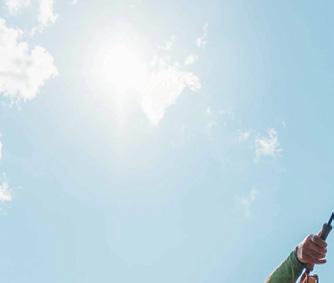


“The Amazon jungle provides some of the very best sight fishing opportunities for top predators, but to close the deal you need to be able to put a big fly in front of them with minimal false casting, so quick rod loading is crucial. The Amplitude Tropical/Jungle Titan Taper is my choice for sight fishing in the clear waters of the Amazon.”
 - Rodrigo Salles, SA Advisor
- Rodrigo Salles, SA Advisor




Featuring aST plus for superior slickness and






2½ TIMES MORE DURABILITY THAN CLOSEST COMPETITOR
• High-contrast sighter to identify the back of the line when fighting fish on long runs
• Floating texture on the tip section for the ultimate in flotation
• Shooting texture running line delivers longer casts


• Powerful head loads quickly and delivers large flies to distant targets

• Built two line sizes heavy
• Tropi-Core technology remains stiff and slick in tropical environments




Working for wild fish and free-flowing waters while crafting no-compromise, durable gear has been our business for 50 years.
That tenacious commitment to our planet and the anglers who fish it will guide us for the next 50 years.

 © 2023 Patagonia, Inc.
Kate Crump defies a harsh wind, the bracing cold and the long odds on Alaska’s Bristol Bay. Jeremy Koreski
© 2023 Patagonia, Inc.
Kate Crump defies a harsh wind, the bracing cold and the long odds on Alaska’s Bristol Bay. Jeremy Koreski
Introducing the new PRO Waterproof Packs. Waterproof. Airtight. UV-blocking. Abrasion- and puncture-resistant. In a word: bombproof, with TPU fully coating the ballistic nylon and designed around the notion of keeping gear easy-to-access and completely safe from all elements.




34. COULD HAVES DON’T COUNT
Could’ve, should’ve, would’ve. Jazz Kuschke grapples with questions of mortality and priorities. If you take anything from this issue, make it this: Take every opportunity you get to go fishing with good people – because you never know which cast will be your last.
38. THE EPIPHANY

Seeking something – a change, distraction, connection, relief –some might say Nick Ferreira came to fly fishing late. But, as he describes the impact fly fishing has made on his life through the filter of a Lesotho trout trip, you could argue it found him at just the right time.
48. TOPWATER TIGER KINGS
Party in the front, party at the back. Guide and fly-tyer Richard Wale explains how two saltwater semi-surface patterns unlocked the topwater bite at Pongola and unleashed his moustache and mullet upon the world.
62. THE CHRONICLES OF LOSS – STURM UND DRANG
We asked several very accomplished anglers about the lost fish that keep them up at night. Amid tears, rage, sorrow and vendettas (against inanimate objects and pizza grease), they bared the dark side of their souls.
76. THE RAY RIDERS OF TAURANGA
“In Tauranga, the kingies behave very differently.” Marine biologist and guide Gian Booysen explains the science and the tactics behind a unique fishery in New Zealand where the kingfish (yellowtail) think they are giant trevally.

The entire Sextant rod family shares a smooth loading, quick recovery action that allows for precise accuracy at short distances without sacrificing the power and backbone necessary for punching flies at longer distances through the wind.

THE SEXTANT SALTWATER SERIES. 7 MODELS FROM 6 - 12 WEIGHT
est 1969
THE ROD YOU WILL EVENTUALLY OWN
www.thomasandthomas.com HANDMADE IN AMERICA
Fish long enough and there will be fish that return to you in your dreams. These are not fish you caught, no sir. That would be too easy for your brain to handle. Those fish are hanging on the metaphorical trophy wall of your ego, next to anything else your subconscious frames as part of the overall patchwork of your life’s 15 minutes of fame.
No, the fish that return to you in your dreams are the ones that you did not catch. The ones that you could have, maybe should have, but didn’t.
For me, it was a tarpon off the beach in Gabon in 2017. It was around 5am and with the faintest hint of light starting to play on the chop at the estuary mouth, we were still using our headlights to adjust tackle when necessary. I had just caught a nice threadfin and literally two casts later, I connected with the poon.
Conrad and I could see tarpon rolling right in the vortex where the outgoing river water met the oceanic rip coming off a sandbank. To reach it, I had to cast to the very limit of both my ability and what was doable with the 12-weight at 5am in the dark and the swirling water at our knees. Wading in deeper, with the dropoff, the current and resident bull sharks, was not an option. Pumped up on adrenaline and belief, the cast somewhat miraculously
landed in the right spot. I knew I would have maybe one or two strips before the fly would be swept out of the zone. It only took one. The line went tight, a massive tarpon erupted through the gloom and took off across the bay. I whooped, Conrad dropped everything to talk me through what happened next and I cranked up the drag. And then… nothing. Popped at the knot.
The funny thing is the night before I had peppered our host, legendary saltwater guide Arno Matthee, with questions. One was about his tried and tested knots for big fish and, “Had they ever failed?” He said that had only happened twice in his career. As if I had asked for it, this was the third.*

The loss of that fish never actually stung, perhaps because in my inexperience I was still stoked about the threadfin. But, like a monk who got half a handjob before joining the monastery, I am permanently hooked on the wonder and curiosity of that moment of connection. That’s why not a week goes by without me thinking about that fish. Working on deadlines, driving my car, walking the dogs, taking a shit, or deep in conversation with someone, that poon breaches and takes off time and time again. More than anything I think it’s the power I felt as it surged away from me that runs through my head on an infinite loop. I’m sure a dominatrix would have something to say about the allure of feeling powerless and small, about having no control.
Because The Mission likes to celebrate the failure inherent to fly fishing, in this issue we asked a bunch of accomplished anglers to share their stories about the fish that haunt them. These are people who have caught plenty of impressive fish. If they bothered to keep ledgers, they would be in the black. Despite their prowess, they all had delicious tales of woe and we thank them for taking us to those dark places in their psyches and sharing. Check out their stories in “The Chronicles of Loss” (pg 62).
*To be extremely clear, I don’t blame Arno at all for that fish not sticking. A) You should tie your own knots. And B) If you are inexperienced like I was, you not only have to trust in the guide’s knots but also check them in the dark when you get up at 4:30am, which I did not. And C) Accept whatever happens because you did not do A). Plus there’s D) Very often fish, especially massive ones, win.








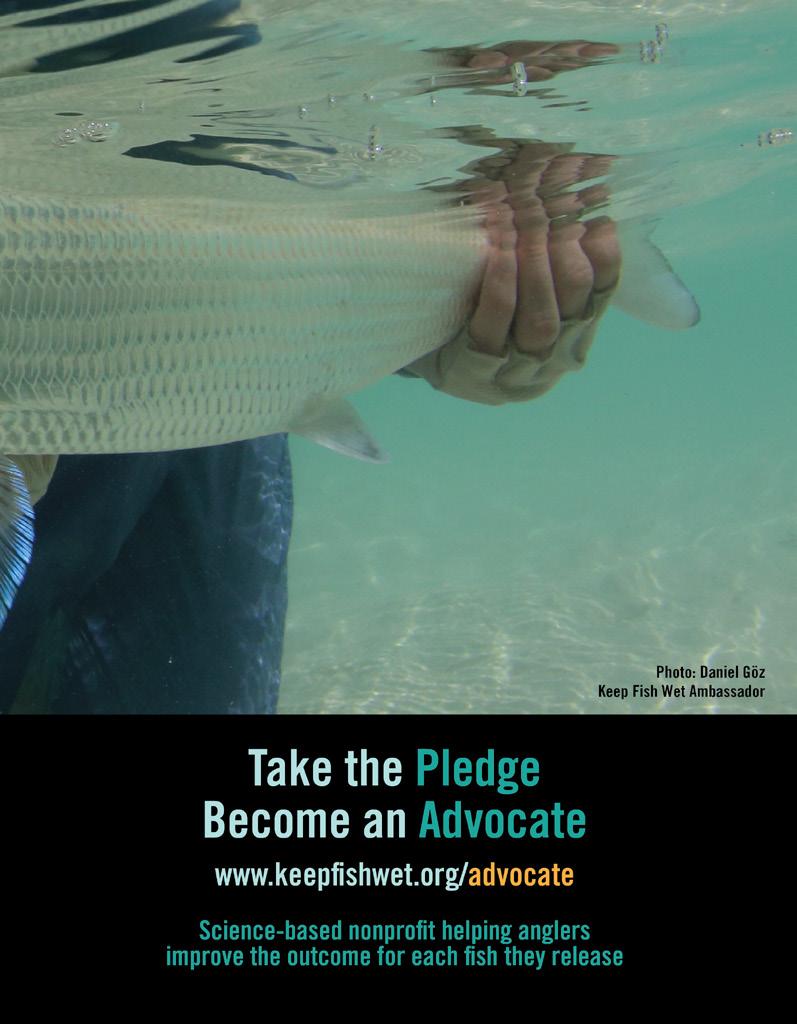
EDITOR

Tudor Caradoc-Davies
ART DIRECTOR Brendan Body
EDITOR AT LARGE
Conrad Botes
CONTENT COORDINATOR
Matt Kennedy
COPY EDITOR
Gillian Caradoc-Davies
MANAGING DIRECTOR
Ingrid Sinclair
ADVERTISING SALES
tudor@themissionflymag.com
CONTRIBUTORS #38
Nick Ferreira, Gian Booysen, Jazz Kuschke, Ewan Naude, Josh Power, Brenton Freeman, Richard Wale, Nic Isabelle, Conrad Botes, Peter Coetzee, Leonard Flemming, Stephen Dugmore
PHOTOGRAPHERS #38
Ruhan Kruger, Johann du Preez, Gian Booysen, Ewan Naude, Josh Power, Brenton Freeman, Nic Isabelle, Jazz Kuschke, Cameron McDermott, Richard Wale, Jonathan Boulton, Travys Owen, Peter Coetzee, Leonard Flemming, Garth Wellman, Matt Kennedy, Helen Dugmore






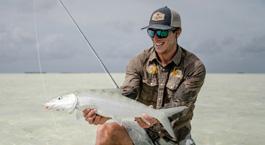



Gone are the days of guessing if a fly line is right for you – Scientific Anglers is returning to South Africa with their hugely popular BRING YOUR OWN ROD events. Essentially, it’s like speed dating for fly fishers where you get to find the perfect match for your rod by trying out tons of different lines. To find the perfect fit for your fishing applications – be it delicate presentations to fussy fish or long-distance bomb delivery to behemoths – all you need to do is rock up with your rods. The Joburg event is at St Stithians on 11 March, the Durban event at Hillcrest Villagers Athletics Club on 12 March, and the Cape Town event at SACS on 18 March. frontierflyfishing.com

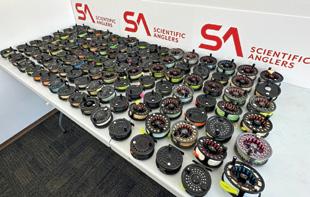
…THE AUSTRALIAN FLY FISHING PODCAST. Wallaby scrummie Nick White’s overly sensitive moustache aside, Australia has a lot going for it, especially when you’re wielding a fly rod. Listening to host Josh Power of The Australian Fly Fishing Podcast is a great way to get to grips with the continent’s fly fishing offerings. Though it’s Oz-focused, Josh doesn’t limit himself geographically and has even featured our very own human Chewbacca Andre van Wyk. We also recommend checking out his interview with former Durbanite Justin Webber who started In The Salt magazine. For more from Josh, check out his intro to southern saratoga in this issue’s Wish List Fish (pg 22). australianflyfishingpodcast.podbean.com

“ESSENTIALLY, IT’S LIKE SPEED DATING FOR FLY FISHERS”
MORE FIGHT, MORE TOUCH
Load shifted closer to the hand prioritizes feel and recovery. 25% greater strength for increased pulling power.
Distributed by Frontier Fly Fishing www.frontierflyfishing.co.za










Yes, you read that correctly. Over at The Mission Blog, Peter Coetzee interviews Tim Babich – head guide at FlyCastaway – on developments at Providence where bumphead parrotfish have recently been caught on floating flies that imitate turtlegrass seedpods. To put this into perspective, ordinarily bumpies are targeted with crab patterns. Getting them to eat a dry fly? Unheard of. themissionblog.com

…ON
Xplorer Fly Fishing are living up to the brand name with an xciting xpedition to the Malagarasi River in Tanzania. Unlike other well-known Tanzanian rivers that run east, the Malagarasi starts from up near the border of Burundi and then runs south-west before feeding into Lake Tanganyika. Xplorer has three prime weeks locked down in October to drift a section of the Malagarasi and fish for Tanzanian tigerfish (like the fat boi pictured here), vundu, and local yellowfish species. Email retail@xplorerflyfishing.co.za to find out more.
Gamechangers are nothing new, but Blane Chocklett’s revolutionary pattern is not something that’s readily available in most South African fly shops because, well, they take time and skill to tie. If you’re not going to tie them yourself but you want to stock your fly boxes for the upcoming winter trout season, check out the beauties being tied by Kevin Short/@FlyGenik who clearly has the skill and the time. He also ties larger versions for targeting largemouth yellowfish. instagram.com/flygenik
YOUR FISHING FUTURE ACCORDING TO YOUR STAR SIGN AS READ BY BABERMAN, THE LEGENDARY GRUMPY CATFISH.
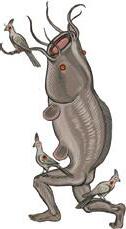
Pisces (February 19 – March 20)
Last week I was seated on the throne, flushing a brown trout, when Neptune’s kiss (Google it) invoked in me a vision of the future. I saw fools ruled by water, ever thirsting to feel the wetness of a wading leg. Pisceans are ruled by Jupiter, not to be confused with Venus the dominatrix. The eye of the giant planet has prophesised that on your next cast you should present a hopper-dropper combo – all the more likely to be blessed in catching two trout with one cast! (Don’t even get me started on the quad-fly combo…)
Aries (March 21 – April 19)
Old goats, angry goats, squint goats and fainting goats. This is your month to be the goated GOAT. The Three Sisters from Orion’s Belt took a break from holding up his junk to tell me that you need to nibble the hooves of the next ram you see and fashion a hook from his toenails. Next off, pluck the third whisker lining the right hemisphere of the scrote (caress the ram with care at this point). Combine this with a tuft of darkened fur, pulled from between two dingleberries and a tungsten hotspot bead, and you’ll have the ingredients for a magic fly. Think Jason and the Argonauts, but more Nigel and the Rancidnauts. It will catch anything. Or nothing. What do I know? I’m a catfish on acid.

when it comes to these fi sh,” he says.


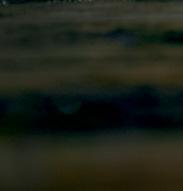


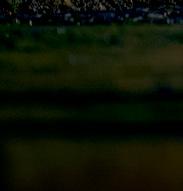






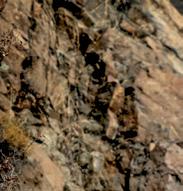

Built using our durable 70% recycled face fabric and game-changing vacuumformed booties, our versatile, neoprene-free Swiftcurrent™ Ultralight Waders work simply and simply work—for you and our home planet.






“I want to take care of this fi shery for the future. It’s tribal tradition. It’s my family.” Arian Stevens


Wild fi sh activist and guide Matt Mendes roams his Deschutes home waters on the Warm Springs Indian Reservation. “I’m a passionate person



Now children, what do we find in the forest apart from bear poop, poison ivy, tiny troot, randy Greek nymphs and the Unabomber? We find the inspiration for Glenmorangie’s A Tale of the Forest, that’s what. The Tain distillery’s first whisky crafted from barley kilned with woodland botanicals and aged in bourbon casks, this release is worthy of Pan himself. Expect a lush, leafy dram with a wintergreen mint palate bolstered by hints of licorice, with a citrus punch, aromas of pine, juniper, coriander and smoke, and tasting notes of eucalyptus and bitter orange with a gentle oak finish. glenmorangie.com, justlikepapa.com/in-good-spirits-co
What do you consider your home waters? Where did you learn to fish?
The rivers of the Eastern Cape Highlands all the way –Rhodes, Barkley East and Maclear. I’ve learned from the best and found that all roads lead back to the Maloti Mountains. From seven years old, every holiday was related somewhat to fly fishing in the Berg, where all of my learning happened. In a family of four boys it was hard not to be a fly fisherman.
What sort of fly fishing do you feel relatively adept at and where would you be completely out of your depth? Small stream trout fishing is my speciality. I am well versed in the realm of trout hunting and can get extremely technical in the most trying conditions. I’m yet to be deflowered on an estuary, something I’m itching to sort out.
You get to choose any destination anywhere in the world to fish with one person. Where are you going and who are you fishing with?
That’s a simple one – the best guide in the world, Dad. We’d go back to the Routeburn River in Queenstown, New Zealand. Hopefully, this time I’ll be able to hold my own in the rapids and haul in some great big mother of a fish.
The most memorable fish you ever caught?
The Mission recently welcomed some fresh meat onto the editorial team in the shape of Parktown’s finest, Matt Kennedy. He shoots, he snaps, he writes, posts, philosophises and fishes (duh). After bombing down the N1 from Joburg to Cape Town to take up the role of our new Content Coordinator, Matt had plenty of music in mind when asked to provide this issue’s playlist, from Foals to RHCP, Ben Howard, Fleetwood Mac and more. We also shot him a few questions to give us some insights into what makes him tick.
A solid 12” on the upper Bell in the Eastern Cape – a trophy for the small section of stream. The low-lying rainbow was overcome by my tenacity to fish the hell out of a run, on a borrowed Sage 000-weight from Tony Kietzman for my 23rd birthday. There was stoke all around that day.

If your fly fishing epitaph were written today, it would say…?
Here lies Matt... slasher of waters, lucky biscuit (family records), long-line releaser, bird-nerd and somewhere would be written my father’s eternal words to me, “Slow your fucking casting down!”
LISTEN TO MATT’S PLAYLIST


WHAT’S NOT TO LOVE ABOUT SOUTHERN SARATOGA? THEY’RE PREHISTORIC-LOOKING, SERPENT-LIKE FISH THAT LIVE IN SOME OF THE MOST INCREDIBLE INLAND WATERWAYS, CAN BE SIGHT-FISHED, WILL HUNT DOWN A FLY LIKE A DOG WITH A BONE, AND JUMP AROUND LIKE ANDRE VAN WYK AFTER A SKIN FULL OF RUM AT A HOUSE OF PAIN CONCERT! JOSH POWER OF THE AUSTRALIAN FLY FISHING PODCAST PROFILES THEM AS THIS ISSUE’S WISH LIST FISH.
Photos. Josh PowerAustralia is lucky to call some pretty incredible native freshwater species home, from our iconic barramundi, sooty grunter and jungle perch in the north to Murray cod and Australian bass in the south. We are also lucky to have two species of saratoga, the northern saratoga Scleropages jardinii and the southern saratoga Scleropages leichardti. Both are part of the sub-family of arowanas; the leichardti is the larger of the two species with a rather small distribution, unlike its relative, which can be found throughout Asia, Africa and South America. Like the Queensland lungfish, it is a true living fossil with records that date back to the Eocene period. Badass!
The southern saratoga, aka tropical trout, is endemic to the Fitzroy River system and its tributaries in Central Queensland, including the Dawson, Isaac and Mackenzie rivers. This species of saratoga, commonly just known as “toga”, can also be found in the Mary, Burnett and Burdekin rivers along with a host of stocked impoundments including Lake Borumba, Cania Dam, Lake Boondooma and Hinze Dam.
Toga are mouth brooders, with the females carrying the fertilised eggs inside their mouths until they are ready to hatch. In the wild, saratoga between 60 and 70cm are considered good fish, while fish between 80cm and 1m are possible in the impoundments where food sources such as bony bream are abundant.
The saratoga has an elongated body with a single dorsal fin found further back and large scales that can vary in colour and often carry bright red or orange spots. It has small sharp teeth, large eyes that allow them to spot prey easily, an upturned jaw which has a couple of barbels on the chin, and a hard bony mouth.
When spotted cruising high in the water column, saratoga swim like snakes or eels and can make great sight-casting targets. They are very opportunistic feeders due to their large eyes that are located on top of their head. Their diet consists of insects, fish, frogs, rodents, lizards and shrimp. Surface flies like foam cicadas, frogs, gurglers, hoppers and beetle patterns are great options in the rivers when the water clarity is at its peak and allows the toga to easily find their food. A delayed response when setting the hook can see an improved hook-up rate.
Leech and bunny patterns as well as toad flies can be fished successfully just below the surface, with the toga often sitting behind the fly before hitting it with gusto. Using fine gauge hooks such as Gamakatsu B10S and Ahrex stinger hooks certainly makes a difference when trying to penetrate their bony mouths. Ensure you employ a proper strip strike as opposed to the dreaded trout strike. A 6- to 8-weight rod with a floating line is perfect for cruising fish. In the impoundments, a sinking line can be an advantage when targeting pressured fish deeper down. A 14 to 20lb tapered leader is ideal, particularly on larger fish. Staying connected to a jumping saratoga can be thrilling and frustrating at the same time.
“SARATOGA SWIM LIKE SNAKES OR EELS AND CAN MAKE GREAT SIGHT-CASTING TARGETS.”
Targeting saratoga on fly can be a DIY option if access to a boat or kayak is possible in the southern rivers or impoundments. In waters north of Bundaberg, access can be limited due to a lack of public facilities and the increased risk of saltwater crocodiles that inhabit these waters. Nathan Johnston from Guided Fishing DownUnder (guidedfishingdownunder.com) offers private fishing charters in the Central Queensland area, from single day to multi-day trips. As does Paul Dolan from Mackay Fly & Sportfishing (mackaysportfishing.com.au), who fishes the northern-most limits of this species. These charters are subject to weather conditions such as rainfall and water clarity throughout the season.
For more info on species like this or for great interviews with a range of fishy characters, check out Josh’s excellent show at australianflyfishingpodcast.podbean.com

 The eel-like southern saratoga caught by Josh with one of his foam cicada patterns.
The eel-like southern saratoga caught by Josh with one of his foam cicada patterns.
A FORMER TOP-TIER COMP ANGLER, THESE DAYS THE EASTERN CAPE’S BRENTON FREEMAN LIVES UP TO HIS SURNAME AS A FREERANGING, SOLO GUIDE. FROM THE BARKLY EAST AREA FOR TROUT AND YELLOWS TO THE WILD COAST ESTUARIES FOR SALTY THUGS, HE FINDS GREAT FISH IN BEAUTIFUL PLACES.
5 best things about where you guide?
1. Pristine environments.
2. The multitude and diversity of the rivers.
3. B.E.A.S (Barkly East Angling Society) – their hospitality and commitment to fly fishing is impressive.
4. The untapped potential to explore.
5. The vastness and scenery of the landscape is truly aweinspiring.
5 fishing-connected items you don’t leave home without before making a mission?
1. My green mirror Costas.
2. An all-weather jacket.
3. Headlight.
4. Knife.
5. Spare reading glasses.
5 bands to listen to while on a road trip?
1. Sugar Shack Sessions.
2. LIVE.
3. Youngr.
4. Trevor Hall.
5. Nako Bear.
5 indispensable flies for freshwater?
1. Gun.
2. Jig Bugger.
3. Tabanas.
4. Hot Spot PTN.
5. Self-tied crab.
5 indispensable flies for saltwater?
1. Chartreuse over white Clouser.
2. Bucktail predator fly.
3. SF blend baitfish.
4. Seaducer.
5. Crazy Charlies
5 of the most difficult guiding/teaching experiences so far?
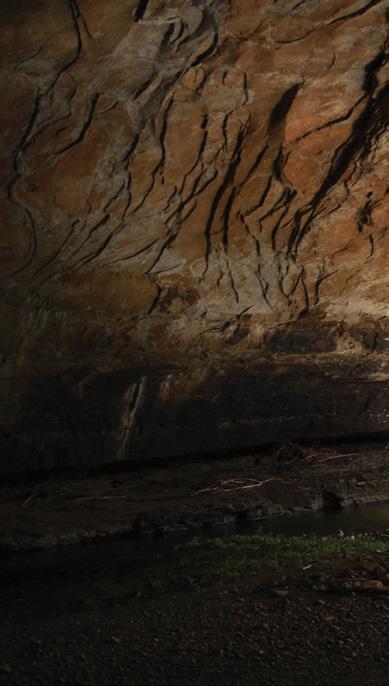
1. Trying to teach a group of 10 kids on a super-charged sugar high. The moms had generously over-filled a cooler that they had packed as a group. These kids decimated it in five minutes flat once the moms were out of sight. That was a challenge.
2. It’s safe to say that there were extenuating circumstances.
However, hitting a sand bank and watching your two clients fly over the bow and breaking a rod in the process, is certainly not my proudest moment in 30-odd years of boating. Luckily, no one was injured and they took it in their stride continuing to fish the day out with me, leaving only my pride a little bruised.
3. Father-and-son trips, where the father is a little too critical and controlling. I understand he has expectations. However, it saps all the enjoyment out of the whole experience and is a tricky situation to navigate as a guide.
4. More embarrassing than difficult… I once was onboard my charter boat, sitting on the bench console, behind the helm, with my leg up to one side showing my guests how to tie up leaders. I was blissfully unaware
that my baggies had a fair size hole in them in a strategic position, letting my parts hang out, in full view of all on board, women and children included. Not cool.
5. Having to perform with a hangover is never good.
5 things you’re loving right now?
1. Fruit. Seriously loving it. Maybe it’s just a summer thing but I can’t get enough.
2. Physical training, calisthenics and MMA (mixed martial arts).
3. Strangely enough, having long hair. It gives me a sense of well-being and freedom.
4. My new truck, “The Beast”, a kitted out 2006 Mitsubishi Colt 2.8 Tdi, Xtreme double cab 4x4.
5. Exploring the Transkei Wild Coast.
 For a moment Brenton Freeman contemplates troglodyte life on the rivers of the Eastern Cape.
For a moment Brenton Freeman contemplates troglodyte life on the rivers of the Eastern Cape.
5 favourite fly fishing destinations across Africa?
1. Zambia.
2. Mozambique.
3. Transkei/Wild Coast.
4. Eastern Cape Highlands and Lesotho.
5. Garden Route.
5 favourite fly fishing destinations globally?

1. Seychelles.
2. Mozambique.
3. Florida Keys.
4. Caribbean.
5. East coast of South Africa.
5 of the worst things you’ve picked up from guiding?
1. A shortage of leader and tippet material.
2. Somewhat of a fixation with punctuality.
3. Frustration over not being able to alter weather patterns.
4. The pressure to produce.
5. A disdain for giving first day casting lessons after the client had clearly stated that they were “proficient”. Generally, I have no hassles teaching casting. I would just like to know in advance.
5 of the best things you’ve picked up from guiding?
1. Making connections and getting to know people who share similar passions.
2. Clients who have now become friends.
3. Swapping stories, experiences and knowledge.
4. The opportunity to apply and develop my skill sets.
5. Adventure and travel.
5 flies to pack (in the smuggler kit under your driver’s seat) to cover most species?
1. Jig Bugger.
2. Gun.
3. Clouser.
4. Popper.
5. Baitfish.
5 people you’d like to guide or fish with?
1. Grant Hartman.
2. Keith Rose-Innes.
3. Marissa Wil.
4. Matt Harris.
5. Joe Rogan.
5 things (outside of the fishing) that make where you fish so special?
1. The Eastern Cape is frontier country in the true sense, remote and vast.
2. The numerous caves and rock art sites.
3. Some of the highest mountain passes in South Africa.
4. Pristine environments
5. The endless rivers.
5 fish on your species hit list?

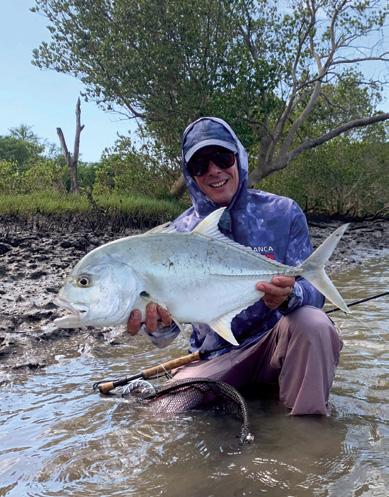
1. Milk fish.
2. Rooster fish.
3. Permit.
4. Golden dorado.
5. Artic char.
5 of the most underrated species in your book?
1. After spending some time coastal gully fishing, I have new respect for blacktail.
2. Blue fish (aka bronze bream).
3. Striped mullet.
4. Flathead mullet.
5. Skipjack (lady fish).
5 destinations on your bucket list?
1. Cabo San Lucas – Baja.
2. Belize.
3. Bassas da India.
4. Lakshadweep Islands.
5. Bolivia.
5 things you would take up if you weren’t always fly fishing?
1. Sailing, although there are plans afoot to incorporate this more in the future.
2. Focus more on surfing.
3. Mountaineering.
4. Return to snowboarding.
5. Adventure racing.
“MAKING THE TRANSITION FROM FRESH TO SALT. ROD TIP DOWN, LINE POINTED AT THE FLY AND STRIP STRIKE LIKE YOU MEAN IT.”

“THE EASTERN CAPE IS FRONTIER COUNTRY IN THE TRUE SENSE, REMOTE AND VAST.”

5 common mistakes that most clients make?
1. When targeting predatory fish with surface patterns, not getting the fly to start moving the instant it hits the water.
2. Underestimating how fit one must be in order to navigate through and over terrain when covering water.
3. Casting is always a thing. My advice is to really make the time to practise, be creative, play and enjoy the art of casting. It only benefits you through ability.
4. Finding it difficult to let go of conditioning. Be open to trying new things and learning.
5. Making the transition from fresh to salt. Rod tip down, line pointed at the fly and strip strike like you mean it. You would think it would be quite simple, right?
5 things about fly fishing that you may never understand?

1. My sheer obsession and life-long journey with fly fishing.
2. How the fish have lockjaw on a particular day for no apparent reason.
3. The complexity and effects of micro-climates on fishing.
4. When hooking say a dorado (mahi-mahi) and you keep him close to the boat, his buddies keep hanging around. It’s silly, though it makes for good fishing.
5. How people can possibly oversleep when there is an early morning fishing trip planned.
5 essential ingredients for an incredible mission?
1. Quality coffee.
2. Even better, quality rum.
3. All-weather gear.
4. Fire.
5. Authentic people to share the experience with.
Your last five missions were for…
1. Kob on the Wild Coast.
2. Skipjack at Swartkops.
3. GTs along the Wild Coast.
4. Ragged-tooth shark in the Eastern Cape.
5. Largemouth yellows in Barkly East.
“MY ADVICE IS TO REALLY MAKE THE TIME TO PRACTISE, BE CREATIVE, PLAY AND ENJOY THE ART OF CASTING.”
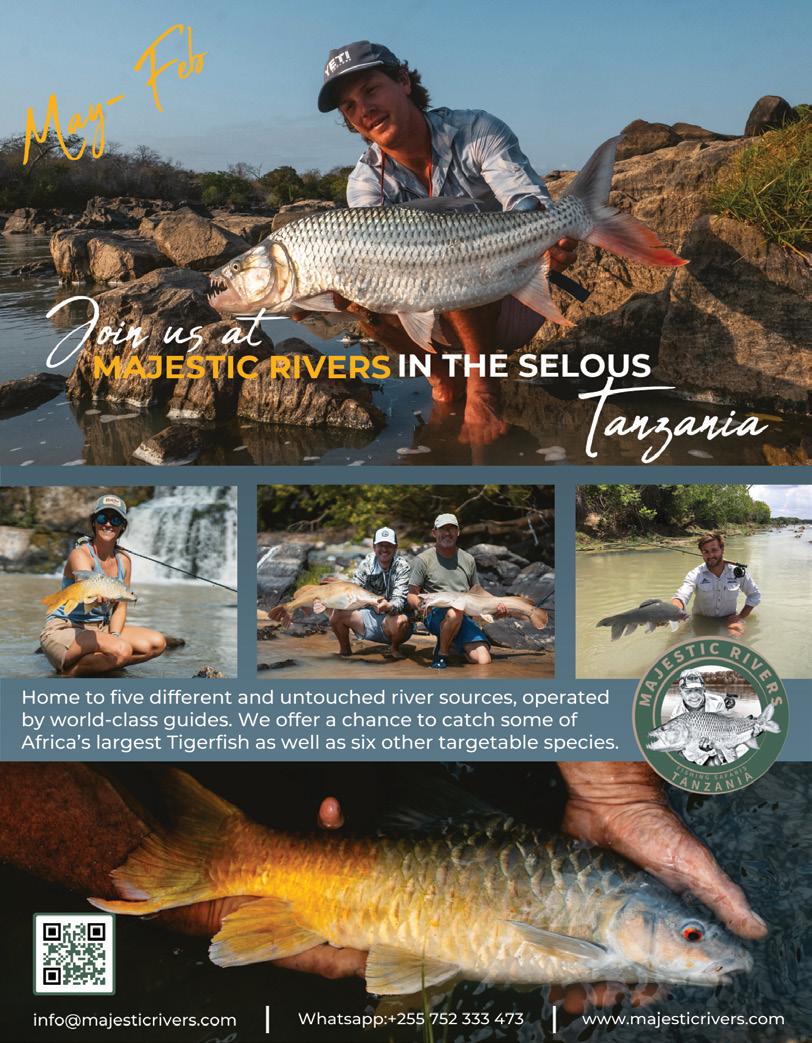
Inever got to fish with G. There was a potential Richtersveld drift somewhere in 2019 but I couldn’t make the dates work. In 2020 I got to fish for homegrown tigers in Pongola (one of his favourite fisheries) but his guiding and work-admin schedule had him elsewhere occupied. When he started opening up his Clarens operation he flooded me with pics and videos and the door and a spot on the raft were always open. I hadn’t been back to the Eastern Free State since 2011 and was positively frothing to fish the Ash River with him from a drift boat and get to see some of the still waters he’d syndicated.
Again, life and responsibilities kept getting in the way and things were postponed. Always brushed off with a, “We’ll make it happen next time.” You know how it goes. In early and mid-2022 there were three times (or was it more?) when the open weekends again just didn’t line up. Finally, we penned one into the calendar for October. The dates were set and I was going to head down there with The Mission editor Tudor to fish the Ash and hang with G. Alas, by mid-September it was pretty clear that there was no way it was going to happen as his condition had taken a drastic turn for the worse.
I never got to fish with G. In late December he lost his brief, brave battle with aggressive cancer. I can’t begin to imagine the pain and loss his wife and young daughter have had to endure and my heart goes out to them. In the days that followed his passing, amid a flood of heartfelt social media tributes to a man hugely respected in the industry and loved as an all-around good oke, came a sting of personal, almost selfish regret.
I never got to fish with G. We’d become pretty good mates over some four years of working together and the often talked about “reality hit” struck me pretty hard, complete with the heavily clichéd “perspective” people often talk about after a traumatic event.


I could’ve gone fishing with G. I could’ve gone to Sedge with LeRoy the other day. I could’ve joined Johann when the bonnies were at their thickest right next to the bricks. Could have. Should have…
Could haves don’t count.
Long-time African overland guru and philanthropist Kingsley Holgate has a parable he famously relates around campfires when new travellers join his convoy. It usually starts with a question from the newbie on how Kingsley has managed to “justify” a life of adventure. By all accounts, he relishes the interrogation because it allows him to put forward his seven-pebble theory.
To broadly paraphrase what was retold to me on separate occasions by renowned travel journos and long-time mentors of mine, Don Pinnock and Patrick Cruywagen, it goes like this:
Kingsley will collect seven river pebbles and lay them in a row in the sand. The bearded old salt will then proceed to tell you, in between sips of rum, that each of these pebbles represents 10 summers, totalling 70 summers –the number of years in a “fortunate” person’s lifespan.
I’m 42 now, so, Kingsley would reach down and toss four of the seven pebbles into the darkness. Forty-odd years… gone forever! A healthy, happy family; a good batch of passport stamps; some great experiences as a full-time travel journalist and (eventually) freelancer; a fair amount of good fishing and the odd regret (but not too many). The point is those years are over. The run has been fished, and the pool purged.
I never got to fish with G… but there’s no use, as Kingsley would put it, “gazing into the rear-view mirror of life.”
Of the remaining three pebbles you now need to consider the seventh (last) pebble. There’s simply no way any of us can guarantee we’ll still have the legs to wade the Smalblaar, let alone clamber over the rocks to reach the bonnies and the yellowtail we have our sights set on right now. And if any of us do, it will be a gift.
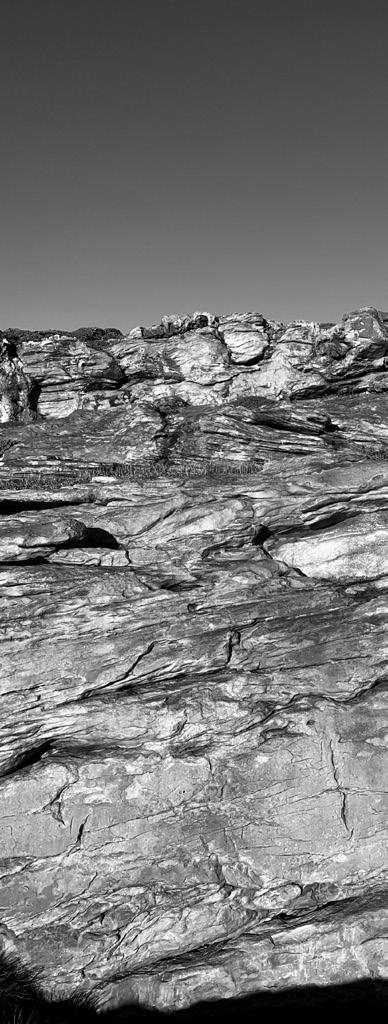
So what? That leaves two pebbles. My two pebbles. How many do you have left? You already know the moral of the pebble story, but I’m going to lay it out anyway: If your mate calls today with a last-minute mission plan to head to Tankwa for this weekend, you should start packing. If you can take your dad or mom fishing tomorrow, do it. If your son or daughter wants to go chase leeries, don’t give them some everyday excuse and tell them you’ll go tomorrow when the tides and wind are better.
With a young family and a freelance business, I’m the last person to tell you to shirk life, relationship and work
responsibilities (and those who know me will attest to that). But the reality is that you just don’t know when you, or your mate, will swing their last cast.
And, if your last cast was the one you threw on your last session, would you have fished it differently? I know I would’ve. Could’ve … Does it even matter how you fished it? Perhaps more poignant is who you fished it with.
I’m a big fan of the late, great American author and essayist Edward Abbey. Much of his writing is centred around environmental issues, criticism of public land policies, and anarchist political views. Perhaps my favourite bit of his work is framed on my desk (a cutout of an old Outside magazine in which it was the caption for the inside back page’s “Parting Shot” as far I can recall). It reads:
“One final paragraph of advice: do not burn yourselves out. Be as I am – a reluctant enthusiast… a part-time crusader, a half-hearted fanatic. Save the other half of yourselves and your lives for pleasure and adventure. It is not enough to fight for the land; it is even more important to enjoy it. While you can. While it’s still here. So, get out there and hunt and fish and mess around with your friends, ramble out yonder and explore the forests, climb the mountains, bag the peaks, run the rivers, breathe deep of that yet sweet and lucid air, sit quietly for a while and contemplate the precious stillness, the lovely, mysterious, and awesome space. Enjoy yourselves, keep your brain in your head and your head firmly attached to the body, the body active and alive, and I promise you this much; I promise you this one sweet victory over our enemies, over those desk-bound men and women with their hearts in a safe deposit box, and their eyes hypnotised by desk calculators. I promise you this; You will outlive the bastards.”

The sad truth is Mr Abbey was only half right here: You or your mates might not actually outlive the bastards, but at least you can “live” richer than them.
Go make those pebbles count.

SEEKING SOMETHING – A CHANGE, DISTRACTION, CONNECTION, RELIEF – SOME MIGHT SAY NICK FERREIRA CAME TO FLY FISHING LATE. BUT AS HE DESCRIBES HOW IT HAS MADE AN IMPACT ON HIS LIFE, HE MIGHT ARGUE IT FOUND HIM AT JUST THE RIGHT TIME.
 Photos. Ruhan Kruger, Johann du Preez
Photos. Ruhan Kruger, Johann du Preez
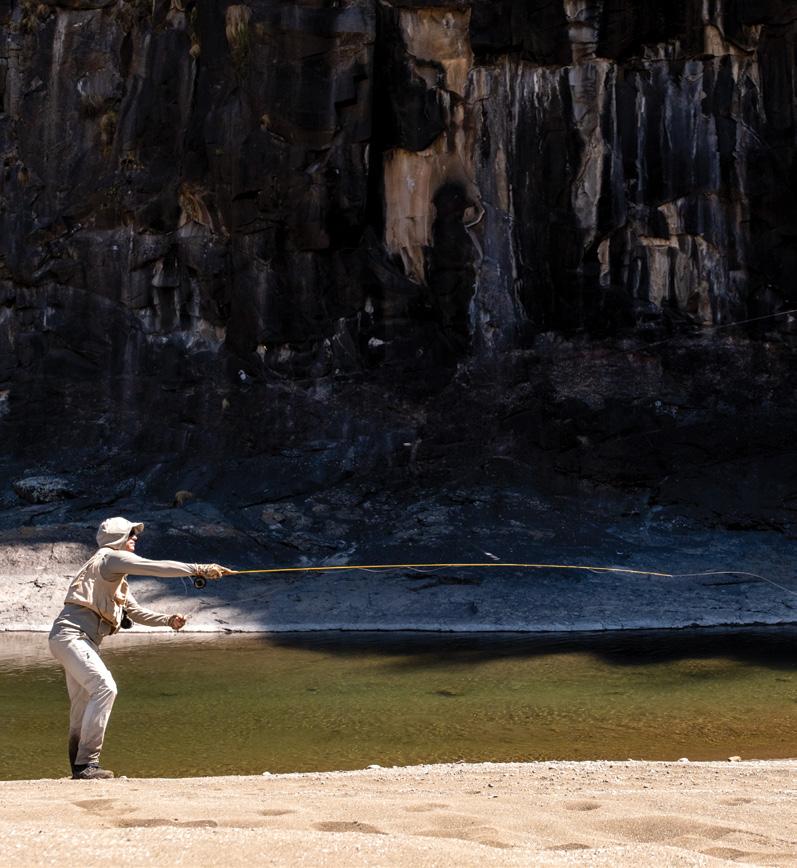
It’s been one of those nights in a tent with the wind flapping and rain spattering the canvas, kept half-awake by the noise. The constant drumbeat is ominous for our plans to fish up the gorge tomorrow.

At some point the steady percussion on the tent changes tone, and I think the rain is easing. But, when I stick my head out, rain has turned to snow, settling rather than thudding onto the tent.
After sunrise I try some conversation around the fire, but I’m driven back under canvas by the wind and sleet. I give up the idea of fishing for the day, and retreat to my paperback and sleeping bag.
Around noon, water stops falling from the sky. The sun emerges and my tent warms. Outside, the valley is blanketed in white but the grass around our campsite is back to a damp yellow, and plumes of white mist rise from the ground like an army of ghosts. The sky clears, and the guides tell us to rig up.
Within an hour I’m casting a dry dropper up the bubble line and striking as 10-inch rainbows joyfully attack both dry and nymph.
Johann du Preez, international guide of mystery, raises an eyebrow at my beloved 7-foot 3-weight glass rod. Soft action, almost impossible to break a fish off, but does it have the backbone to deliver a nymph with precision?

“WITHIN AN HOUR I’M CASTING A DRY DROPPER UP THE BUBBLE LINE AND STRIKING AS 10-INCH RAINBOWS JOYFULLY ATTACK BOTH DRY AND NYMPH.”
For the first 40 years of my life, I had no interest in fishing. As a kid, I sometimes went to the Witbank Dam with a spinning rod to try to catch bass, under the supervision of family friends whose father had a boat and equipment, and knew just what to do.
My dad was a workaholic attorney who was not merely uninterested in, but actively disliked the great outdoors. If social pressure required his presence at, say, a dads-andlads camping weekend, he would sit talking and drinking at the braai while my brothers and I poked hopelessly at the tangle of line and sinker that immediately engulfed the cheap rod and reel Mom had bought for the occasion.
So when, as the first lockdown ended, my friend Rob invited my family to spend a weekend at their fishing place near Dullstroom, I was happy to go but didn’t plan to fish. I had been to that place before. Rob and I survived boarding school together and, from time to time, various combinations of boarders went out there for a weekend.
I had never touched a rod on any of those visits. I was always preoccupied with other goals. In 1993, hitting the other Form 1s with a kleilat (limited success); in 1997, after matric exams, getting intimate with my religious girlfriend (zero success); and in 2001, on a university holiday, trying to enjoy smoking dagga (manifest failure).
But I eventually said yes because we’d had enough of being stuck at home with Covid. At Rob’s suggestion, I bought a little spinning rod in case the kids wanted to have a go.
On the first evening, we all went down to the bottom dam. Using my son’s rod, I cast a black Woolly Bugger out and reeled it in. For some reason, when everyone else walked back up to the house, I stayed on the dam wall.
It was winter in the Mpumalanga highlands: dead still, with the dusk light turning luminous. I could hear my children laughing and shouting in the distance. No fish came.
At that precise moment, it got me. I don’t know how or why, but I understood instantly that standing by that water, casting occasionally and retrieving, thinking of fish, was something I wanted to do.
So began a process that every late-starting fly fisher knows: learning to cast a fly rod, with its peculiar rhythm and unnatural pause. Figuring out which knots attach leader to line, tippet to leader, fly to tippet. Getting advice from fishing shop guys (is it long enough? Is it strong enough? Will the knots hold?).
Many of those first knots did not hold. On one of the first solo days of fishing, after hours spent trying to present a fly to a rising fish, endless untangling from bushes behind me, I managed to induce a take on a dry fly. The fish probably just wanted to be left in peace. My clinch knot immediately gave way, leaving me with a curlicued tippet end and the trout with my DDD.
I washed arse-first down the Vaal after misreading the current strength. I swore maniacally at plants as I tried to get my fly out of a bullrush and into the path of a cruising fish. But I persisted, and improved.

It’s a good day to be fishing in the mountains. One of those days where, early on, you stop counting. Plenty of small, muscular Lesotho rainbows; a few medium rainbows; and even one or two baby browns. They all want a little copper Bead Nymph. At some point I switch to a silver bead just for variety, and immediately start getting refusals.
Just before lunch, Johann spots a proper fish, feeding in the river right beside us. We crawl up behind it, on the right bank, using a clump of yellow grass as a screen. The fish is relaxed, but it is close. Too close. How am I going to turn the leader over from here without lining him?
Johann holds the fly between thumb and forefinger. I straighten up onto my knees, slight shake in my hands. He nods. I whip the glass rod back and forth in the air. I just can’t get it to load. Flip, flap, splash, the line collapses into a pile of spaghetti on top of the fish, which scoots upstream so fast we lose sight of it.
“Fuck, sorry man. “Don’t say sorry. It was your fish.”
As we walk upriver, I think about asking Johann to take the next shot we get at a big fish, to get our team some redemption. I imagine there’s a guiding rule for this situation. Rule 12: when a client pathetically invites you to cast to a big fish, always refuse. If you miss the fish, he will not respect you; if you land it, he will not forgive you.

Friends and colleagues often ask me to explain my new obsession. I don’t have a complete answer.
But it’s probably not a coincidence that fly fishing came into my life at the same time that jolling went out.

I started partying when I was 14. Drinking made me feel more comfortable in my skin and made it easier to talk to girls. But it also felt like a grand rebellious gesture, a middle finger to the world. My friends and I liked to think we were after something more than just getting pissed –adventure, insight, transcendence. We were trying, in our fumbling, inept way, to get a feeling of connection, night after night, sucking the marrow out of life with booze and whatever else we could lay our hands on.
On some nights we achieved it. Out in a field in Somerset, as the sun sets, and Arcade Fire starts to play; the universe would open up and merge with us, merge us into each other and the rest of the crowd and the band. Or at least it felt that way.
But eventually it started to be nothing more than the thing we always did when we saw each other, a routine obliteration of consciousness, a dulling rather than a sharpening. I’d had enough, and I was scared by what addiction had done to the beautiful mind of someone I love.
So is it a coincidence I started fishing around the same time I got sober? I don’t think it was. Fly fishing primes you for transcendence.
You are outside, an animal amongst animals, in their world. The weather does things to you. You get burnt, wet, tired. You watch, listen, pay attention. Your mind is solving problems set by fish and insects and trees and water. You try to put yourself into the mind of a fish, to fool a fish, to catch it.
While you are paying this kind of attention, you are fully present wherever you are, and that is usually a place of transcendent, natural beauty. You have the chance to be fully connected.
Connected to what? Why, a fish, and its underwater realm; a river; a lake; an ecology.
When you do what you are supposed to do, and the fish do what they are supposed to do (neither of which is guaranteed), you will hook one
Then there is that shocking tug on the other end of the line, an animal trying to get off your hook, a life which is in that moment connected to your life. On the other end of what David Profumo calls the “lightning thread”, is another wild animal, fighting you. And then, non-fishing
friends ask, do you eat the fish? Not usually. Mostly I net it, maybe photograph it, take the hook out of its mouth and watch it swim away, back into its underwater world.
I like that moment of release very much. It feels reverent, sacred. It is an encounter with wildness ending as it should, with the world returning to its place, leaving me with a beating heart and shaky hands.
Before we set out on the hike down to the river, Johann
hands me a 10-foot 4-weight graphite rod. “Let’s see how you go with this.” My casting improves instantly – better control, more distance, easier to turn and straighten the long leader.
The river is flowing due to the melting snow and rain. The water is crystal clear, and we can see plenty of fish. But they are fussy today. The previous couple of days, any likely looking drift down a bubble line drew a strike. But today they chase and then turn away, regardless of fly, depth, or drift.
Just before lunch, Johann and Ruhan Kruger bring me up to a large, shallow, still pool where they know some monsters live. They instantly spot two fish doing a slow circuit of the pool. One good fish. And one very good fish.
We go into stalking mode, with Johan watching the fish from high on the bank and talking us into position on a two-way radio. We crawl into place, moving only when the fish is cruising upstream away from us, and freezing whenever we are in its line of sight. After 45 minutes of crouch, crawl, freeze, Ruhan is satisfied.
 Johann du Preez and Nick Ferreira use the advanced tri-grip to handle this cracking Lesotho river rainbow
Johann du Preez and Nick Ferreira use the advanced tri-grip to handle this cracking Lesotho river rainbow
“OK, vat jou skoot [OK, take your shot].”
He wants me to cast the dry fly and dropper nymph into the middle of the pool in front of me. Timing is everything, as the cast must land ahead of the cruising monster-fish, but the delivery must happen out of its line of sight.
I am aware of being watched by three guides and one client, sitting high on a cliff behind me. The line and rig sit on the ground on the bedrock beside me.
A gusting wind starts blowing into my face. I blow the first cast, short of the middle of the pool; I pick up immediately and cast again, this wind, short again. Both fish spooked, another chance gone.
We stop for lunch. Chicken wraps and silence.
We walk on up the river, staying well back from the water. Last week Ruhan and Johann found another big fish in a depression between some rocks on the riverbed. They reckon it might still be there. They think it’s a big brown, judging by the way it behaved.
Ruhan goes ahead and radios back: “Hy’s hier. Moerse groot vis [He’s here. Bloody big fish].”
The fish is lying deep, in a trough in the riverbed, protected by a small curved wall of rocks and boulders on the far side of the depression. Above the fish, two current lines converge in a sharp, clear seam.

We are downstream, on the right-hand bank, in front of a sandbank.
“You ready to go get him?” “Yebo.”
Slowly, Johann and I make our way down onto the sandbank.
“You must cast leader only in front of him, onto that point halfway between the submerged white rock and the far bank.”
It’s about a 30-metre cast from where we are, to my 11 o’clock. Blessedly, there is no bush behind me, nothing but clear air for a straight back cast over the river. I can feel the wind at my back. Somehow, the previous failures have freed me of anxiety.
I make two false casts, then release. The line unfurls. The luminous orange post of the dry fly lands, to the left and slightly short of target. I let it drift back past the fish, then pick up, cast again.
Better this time, but still too far left of the bubble line. Drift back, pick up, cast again. FUCK, short again.
I don’t think. I lift the line again, watch it straighten behind me, punch forward. It unfurls, leader uncoiling at head height.
The dry lands in the middle of that tight, dark seam of water, about 1,5 metres ahead of the lie.
Time stands still. For an eternity, there is nothing in the universe but a bright orange piece of poly-yarn accelerating into a seam of current like a miniature whitewater raft entering a rapid. I see, hear nothing else.
“THERE IS SOMETHING OF THAT MOMENT IN ME STILL AS I WRITE THIS, SOME REMNANT OF TRANSCENDENCE AND PRESENCE AND JOY.”
Impossibly, almost imperceptibly, as it drifts over the lie, the orange post disappears under water.
I lift my right arm and tighten the line. There is a solid, heavy pull on my left hand.
That big river fish took the nymph. And now she is on.
Ruhan and Johann erupt.
She jumps once, high, shaking her head in fury, a glowing pink stripe down her side, desperate to throw the hook. I keep the rod tip up, with a shaking hand, and then she is in the net.

For the guides, she is the fish of the season (albeit only a two-week exploratory season), and the ultimate exercise of their skill to get a chump like me into a fish like that. To me she is the fish of a lifetime – not as big as some trout out of stillwaters, but a big wild fish from a wild river and, somehow, a consummation, a confirmation, a celebration.
There is something of that moment in me still as I write this, some remnant of transcendence and presence and joy.
I watch her slip away, over the sandbar. And then she is gone, back to her world, and I am on my knees in a flowing river, and time starts to move again.

Iwas lying on the couch minding my own business in Cape Town when a WhatsApp message pinged from my mate Tyron Knight, with a photo. As the image took a moment to load, I read the proverbial fine print.
“Keep it on the DL and don’t show anyone yet.”
In fly-fishing circles that sort of disclaimer attached to a photo usually means that either the location is sensitive, the fish is spectacular, or the method on which it was caught is unusual. Ty was messaging me from Pongola where he was guiding for Mavungana Flyfishing on Lake Jozini during the autumn tigerfish season. The photo he sent was of Mavungana’s head honcho, Jono Bolton, and the fish he was gripping and grinning was his PB tiger taken on a topwater fly. Jono has been fishing and guiding on Pongola for north of 20 years, so a PB topwater flycaught fish on that system is, for him, an extremely special fish. But what made it extra-special for me was the fly that was lodged in the scissor of the tiger’s jaw.
It was a topwater Stella, a fly I had developed for a totally different fishery that sits a few hundred metres from my home in Cape Town.
For those uninitiated in the ways of tigers, let me put this into perspective. Ninety-five per cent of the tigerfish you catch on fly are caught deep on fast-sinking lines with heavily weighted Clousers in black and red or black and purple. Whether it’s the Zambezi or other tiger fisheries across Africa, it’s hard to go wrong with that simple yet lethal combination. That’s not to say they are not caught on surface patterns from time to time, when anglers are willing to take along a floating line, some flippers, gurglers and other surface patterns and put in the time in low-light conditions to entice a surface eat. Pongola or Lake Jozini, where Ty was guiding, is a different kind of tiger fishery. You will catch fish the regular way, with Clousers and sinking or intermediate lines, but you stand a very good chance of catching fish on the surface or just sub-surface thanks to Pongola’s unique flooded grassland margins.
Tyron and I have fished and tied flies together quite a bit down in the Western Cape. We share a home water estuary, Zandvlei, on which I developed the Stella to target leervis (garrick) that feed on the vlei’s Gilchristella aestuaria (aka Gilchrist’s round herring, a small shoaling estuarine baitfish) on shallow banks and in weed beds. I fish the vlei frequently and although the mouth is opened and closed on a fairly regular basis, there is generally little to no tidal water movement. Having fished poppers, crease flies, sliders, flippers, etc. for years in the vlei, I have witnessed the nuances of how leerie feed on the Gilchristella. The eat is very different to that of leerie chasing other baitfish. The Gilchristella frolic and swirl in low light conditions, just breaking the surface but not fully jumping out. When the leerie feed on them, the leerie often roll like tarpon or make a sudden gulp on the surface. When the Gilchristella are predated on they appear to panic on the surface, sending out tiny water droplets. If you analyse it for hours on end you will notice that this interaction is quite different from the typical mullet jumping out the water with a leerie hot on its tail.

“KEEP IT ON THE DL AND DON’T SHOW ANYONE YET.”Tiger Stellas that have seen a few tours of duty.


“THE TIGERS HAVE SO MANY MICRO-HABITATS FROM FLOODED ACACIA FORESTS HOLDING TOPWATER TIGERS, TO MUD BANK TILAPIA BED MOLESTERS”
Determined to improve my leerie catch rate and with Gilchristella action on the brain, I sat at the vice and set about coming up with something that imitated that unique action. I didn’t want the fly to pop, skate or slide, but rather have a bait fish profile just below the surface and something just breaking the surface to attract attention. I started by tying a natural-looking brush fly with a bucktail back section and a sculpting-fibre body. I then landed up tying in some shaped foam that I folded back and glued down to the top of the brush fly. Usually, the flydeveloping process requires some trial and error but, in this instance, the fly came out right first time and resulted in the movement I was looking for. As an extra unplanned bonus, the shape of the foam and the glued-in downward slanted eyes resulted in those droplets of water being fritzed when the fly was stripped. Just like a Gilchristella. The fly has consistently produced good fish at Zandvlei and other estuaries. Then Ty tied a Stella for Jono to try on the tigers during a guides’ session on Pongola and it soon
became apparent that from species to fisheries this fly had some proper crossover applications.
While I was over the moon to see my Western Cape saltwater patterns do the damage on Africa’s premier freshwater fish, 1 700km away on the other side of South Africa, little did I know that I’d soon be up there too. With some movement in the Mavungana Flyfishing guide roster between their various destinations, I was asked to join the Pongola guide team for the spring season. While I guide a lot in the salt and fresh around Cape Town, I was fritzing like a Gilchristella at the chance.
The start of the season sees us guides putting boats in the water, setting up the war room/office and getting everything ready for six weeks of clients. We have a few days to fish and check things out on the system. Aside from catching a few fish, the main idea is to get the lie of the land and, for newbies, to receive a crash course in learning all the names

and locations of spots. There’s a lot to take in. Lake Jozini is a massive body of water, and a large portion of its banks makes up the border between South Africa and Eswatini. The Pongola River flows through Pongola Nature Reserve into Lake Jozini and creates sets of meandering bends, flooded acacia tree structure, phragmites reed beds, islands, rocky points and drop-offs. From a fly-fishing perspective, it’s a dream, because the tigers have so many micro-habitats. From flooded acacia forests holding topwater tigers, to sight casting to open water surface cruisers or shallow mud bank tilapia bed molesters, the fish and this fishery change from day to day as water levels and weather conditions fluctuate. Hell, at times, you even find tigers feeding on dragon flies and sipping on emergers like stillwater trout.
Following Ty and Jono’s success with the Stella, it had become the fly of the autumn season, which had been jampacked with a lot more topwater tiger action than usual. I’d like to think that’s down to the fly, but it was partially
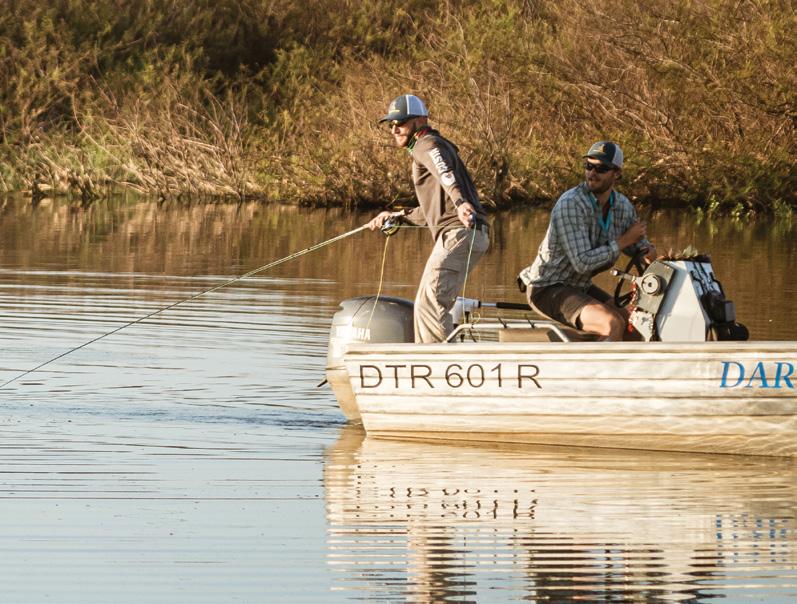
because of how the water levels impact this fascinating fishery. Topwater fishing for tigers is nothing new and they had been targeted at Pongola for some time with the usual crease flies, poppers and flippers. There was some success with topwater flies from time to time, but these would commonly be smaller specimens. Although those flies would generate follows and eats, they would seldom convert into good fish being hooked and landed.
Having chatted to Jono about the history of topwater flies on the system, it’s clear there has been an evolution. Past seasons showed that the tigers didn’t enjoy the loud and obnoxious action of a conventional popper. Inroads were made by creating more of a slider action by, for example, attempting to trim down a NYAP (Not Your Average Popper, the Seychelles GT fly created by James Christmas). It seems the Stella arrived at the right stage in that evolution and, with the addition of a weed guard, it proved perfect for targeting the topwater eat.
Varied structure at Lake Jozini means provides micro-habitats for tigers and high-octane close-quarters combat.When I arrived that spring, with the water levels at the highest they have been in a long time, we focused much of our time up in the river inlet area, which sports a plethora of different structure on either side of the river channels. The masses of dead reeds on the water’s edge were holding tigers in super-skinny water. The tactic was, literally, to cast the Stella on to the bank at times and work it back through the reeds. We were finding good fish numbers, good fish sizes and, more importantly, fish that were focused on the surface. Numerous times while clients were fishing subsurface, flies would get taken as they hit the water close to structure. We frequently saw big fish smash bait fish on the surface both deep in the acacia bush structure and in the open water. Fellow guide Mike Dames became a master of spotting “big cruisers”–double-digit fish cruising in open water on the surface. As the weeks progressed, so the conditions changed and we had to adapt and tweak our approach from session to session. When the water levels were high there were new spots to check out and as the levels dropped other spots came into play. While I saw more topwater tiger action with the Stella than I had ever experienced in multiple
trips to the Zambezi previously, as the water receded slightly, the crazy surface action up in the dead reeds slowed down. Although we did get got some fish on the Stella, the bite seemed to have changed, which meant that the fly/presentation needed to change too.


At our next break between clients, I tied up a silicone mullet fly in baby tilapia colours on an appropriate tiger fly hook. Originally tied by Bob Popovics, the silicone mullet fly has been around for some time now. It has been used predominantly for saltwater species and in the Cape we fish it for leeries with great success, using an intermediate line to get a subsurface side-to-side action. From my experience targeting leeries, I knew that the silicone mullet provided a more subtle surface action than most topwater flies and seeing as the Stella had worked, I thought it might work nicely for the tigers. It also has a nice squishy feel which I hoped might result in the tigers holding onto it a bit longer, giving anglers a chance to get a better hook set. Armed with the silicone mullet and an intermediate line, Mike and I headed out to test it.

“ARMED WITH THE SILICONE MULLET, MIKE AND I HEADED OUT TO TEST IT.”This page from top left: a silicone mullet in tilapia colours, a boat box of tigers snacks and guide Tyron Knight. Opposite: Mavungana Flyfishing’s Jonathan Boulton.



The theory was that I would land the fly close to structure, slide it through the surface film for the first few metres of the retrieve, and then let the line sink and retrieve it subsurface for the rest of the retrieve over the deeper water. It’s a strategy that I have used before for bass fishing from a boat, and it was extremely effective on the tigers. We had a great session pinning more than 20 fish between us. The silicone was working well both on the surface and subsurface. Most of the session was upriver, fishing in the channels of phragmites reeds, but it was towards the end of the session where the topwater potential of the silicone mullet on the surface exploded. At this stage, we were at a section of the dam lined with flooded acacia trees, the perfect structure scenario for fish to hold in. I put the silicone out, landed it next to the structure, gave two strips and slid it over the surface. I then proceeded to light up a ciggie and while I was taking my first drag I witnessed a bus of a fish shoot out of the structure and smash the fly as it sat there static on the surface. I somehow managed to set the hook with one hand holding the rod and line and proceeded to land a solid 13.5lb tiger. With that fish, the silicone fly surface eat was unlocked and from then on, clients and guides fished both it and the Stella with great success.

“And the steamy handlebar moustache?” you might ask. In a recent post, Fly Fishing Nation said, “It seems that fly anglers naturally gravitate towards quirky and odd stuff especially if they have been around for a while.” Whether it’s catching GTs on slip slop bird flies or wearing a pumpkin head while fishing on Halloween, we’ve all seen this go down either in our own circles or leaking out on social media. When you work in a guide team over a season or two, there’s an undercurrent of lunacy that’s almost always there. It makes sense – spend enough time with people in a relatively remote environment away from other distractions and you will develop a language, stories and some dumbass ideas that you just have to execute. Pop culture comes into it too.
Finding new spots at Pongola also meant naming new spots (usually requiring a decent fish to be caught first). Fresh off a Netflix binge during the break between seasons, the Stranger Things theme was running strong with various spots being named things like “The Upside Down” and “Stranger Things”. In my case, Joe Exotic from Tiger King came into play when I took a look in the mirror at the end of the season and saw a somewhat feral chap with lengthy facial hair, a sleeveless camo jacket, trucker cap, long hair and yellow low-light glasses (essentially the whole Joe Exotic wardrobe) staring back at me. Naturally, spurred on by my fellow beard-wielding guides, I trimmed the face fur into a decent set of handle-bars and the Tiger King challenge was set. Now we just needed to get a decent fish while I was in Joe Exotic drag!
“I’D LAND THE FLY CLOSE TO STRUCTURE, SLIDE IT THROUGH THE SURFACE FILM FOR THE FIRST FEW METRES OF THE RETRIEVE, AND THEN LET THE LINE SINK AND RETRIEVE IT SUBSURFACE OVER DEEPER WATER.”


Down to our last afternoon session before the end of the season, I was paired up with Jono who will throw topwater over anything, so we both rigged up with topwater silicones. It didn’t take long for him to get a decent fish with the typical explosive eat on the surface. I then had an awesome topwater eat in a love pocket between some acacias but I missed the hook-up. Shortly after that Jono again a had a solid fish molest his silicone which landed up being a 12.5lb beauty, once again breaking his topwater record within the same season. With Jono having had his fill, the pressure was on for me to get a good fish before it was all over. In the back waters, a scenario we keyed into was that where the flooded acacia trees stretched far back to shallow water, there were tilapia nests. Hanging around those nests were big tigers waiting for them to slip up. It truly is an awesome scenario, creeping in on electric motor and being able to cast at sighted tigers in crystal clear, knee-deep water. As we approached one of these areas, we saw a big smash in the shallows and the wake of a few large fish moving around. After quietly getting the boat into position I made a long cast into knee-deep water where we had seen a fish move. I gave three slow strips and a good fish came onto the fly, smashing it on the surface like a bat out of hell! Hooking a fish in these tight confines dotted with acacia trees and submerged islands is one thing, landing it is another. The close-quarter dog fight that ensued was ridiculous, with the fish doing backflips through the trees and making a bee line for every bit of structure in sight, but, with some luck, I managed to get the fish to hand. It wasn’t the biggest fish of the season but at around 8 to 9lb it would suffice for the Tiger King Joe Exotic challenge. What’s more, Jono happened to be filming the whole thing from cast, to eat, to hook-up and fight. So, we got the pic and the video in the last minutes of the session, and of the season. We later found out that, while we were having topwater fly fishing ecstasy, Mike and Ty were also smashing fish up river from us, also having the “best session of their lives” with multiple double-digit fish.
A few days later as I made my way home to Cape Town (where my moustache/mullet combo was to receive some proper side-eyes from my girlfriend and my son), I ran through what had transpired over the last few weeks. With breakthrough fly patterns and tons of fish on surface, in all my years of guiding, it was truly a season to remember. I wasn’t too bleak to be home though, because as the Uber rolled through the home stretch to my house, I could see Zandvlei. It would be a matter of hours, maybe even minutes before I’d be out there throwing Stellas and silicones to baitfish-munching leeries.



Working with Adam Wyness - a postdoctoral researcher on the Rivers of Life programmeMavungana Flyfishing has invested heavily in the research and tagging of tigerfish on Lake Jozini. The results of this programme will prove invaluable to assist with future conservation efforts of this special fishery. Find out more at riversoflife.co.za.

“THE CLOSE-QUARTER DOG FIGHT THAT ENSUED WAS RIDICULOUS.”Scan the QR code to watch Richard’s step-by-step tutorial on tying the Stella or visit @TheMissionFlyFishingMagazine on YouTube.
IT HELPS TO TALK ABOUT PAIN AND LOSS, RIGHT? THAT’S WHY GROUP THERAPY AND CAMP “KUMBAYA” SINGALONG SESSIONS EXIST. WITH THAT IN MIND, WE ASKED SEVERAL VERY ACCOMPLISHED ANGLERS ABOUT THE FISH THAT KEEP THEM UP AT NIGHT. YOU KNOW, THE ONES THAT GOT AWAY BUT THAT VISIT FREQUENTLY IN THEIR DREAMS. AMID TEARS, RAGE, SORROW AND VENDETTAS (AGAINST INANIMATE OBJECTS AND PIZZA GREASE), THEY BARED THE DARK SIDE OF THEIR SOULS. THESE ARE THEIR CHRONICLES OF LOSS.


I was on a beach somewhere in West Africa. It was about 10 o’clock in the morning and the tarpon were going absolutely berserk just behind the shore break, in broad daylight. It was a spectacle straight out of some National Geographic documentary, and something that I had not experienced before during daylight hours.
There were five of us and we were fishing off a point just outside the river mouth. But reaching the tarpon was difficult, almost impossible. To make matters worse, real estate was limited to two anglers in the sweet spot, and even they needed to add about five metres to their cast beyond the point break to where the fish were rolling and smashing mullet.
I identified the very tip of the point as the spot from where you could reach the fish. The problem was that you would get washed off the point very quickly by crashing waves and end up in a gully behind it. A good name for the gully would have been Tarpon Alley if it wasn’t for the bull sharks we’d already spotted in it.
I walked over to Peter who was fishing close by. “Why don’t you try that point over there, Pete?”
“I don’t want to get washed off into Shark Alley by the first wave,” he replied.
“Do you mind if I give it a try?”
“Go for it,” he laughed.
Watching the surf, I took a lull between two sets of waves to walk out onto the tip of the point. I made a cast that seemed to land in the sweet spot. It must have been two strips in when a tarpon hit the fly and, simultaneously, a wave hit me off the point. All I remember was swimming towards the beach and holding onto the rod with all my might as a big tarpon jumped right on the edge of my peripheral vision.
Eventually I reached the beach where I managed to put the brakes on the tarpon. Some of my friends came running, getting ready to help land the fish. It had been long years since I’d caught a big tarpon in the surf and, while I was really slugging away at fighting it, I was overjoyed at finally catching one again.
I remember seeing the head of the fly line rolling onto the reel; the fish in the shallows with its back and tail fin out the water and Damien walking towards the tarpon in order to grab the leader and secure the fish.
Suddenly, without any struggle from the fish, the line went slack. The hook pulled. I watched as the tarpon slowly slipped over the lip of the sandbar and disappeared.
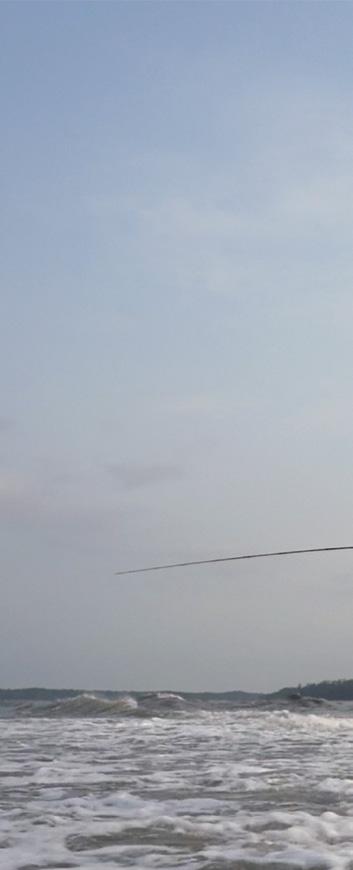
Later I looked at the photos Travys took of me fighting and losing the tarpon. It reminded me of the scene from Platoon where the dying Sergeant Elias Gordon (Willem Dafoe) throws his arms skyward in a gesture of defeat, desperation and betrayal.

I REMEMBER SWIMMING TOWARDS THE BEACH AND HOLDING ONTO THE ROD WITH ALL MY MIGHT AS A BIG TARPON JUMPED RIGHT ON THE EDGE OF MY PERIPHERAL VISION.

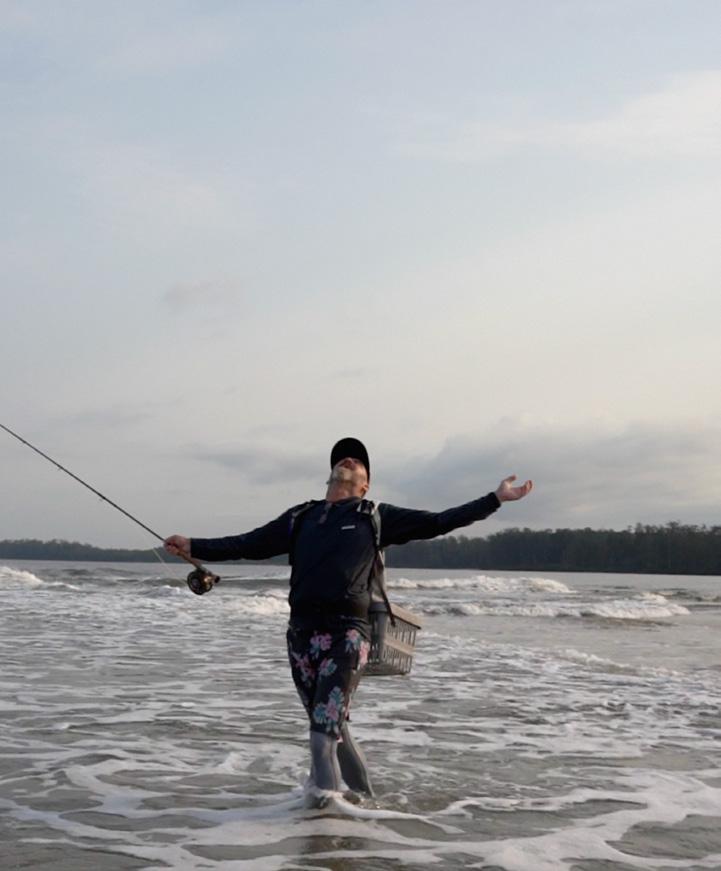
For years I struggled to tick the permit box. I was living in the Bahamas, fishing a ton of saltwater and it just never worked. I had had plenty of shots at it. Then I was in Mexico with Jose Wejebe, probably the best permit angler on the planet at the time, and a camera guy. We were supposed to catch a permit for the camera but we came back with nothing, while my wife caught a giant permit and only had an iPhone picture. There was another time, going through Ascension Bay. We were running the boat and there was a school of about 50 permit. We whipped the boat around to get in front of the permit. They were coming towards us. Bang! One cast, right in front of the lead fish and I was tight… and it was a bonefish.
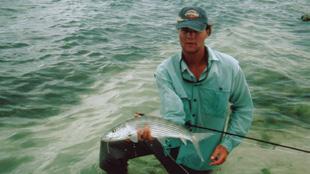
So that’s how my permit fishing was going.
Then, I was filming a show at Abaco, living in the Bahamas and the fishing was fucking lights out. We just crushed it, got the show in the can and then the guys were like, “We’ve got more time and you haven’t caught a permit yet… let’s go do it!” My buddy Clint Kemp, who owns Black Fly Lodge, was guiding so I was in his boat with the camera. We talked about how I had been cursed by permit and how, for years, it just hadn’t connected.

The way we were fishing for permit then is that we would bobble with the boat, stand on the platform and look for rays. If you found the fish on a ray, you’d kill the engine, pole in and take a shot. Those fish were relatively cooperative. We found a fish on a ray like that. When I went to make a back cast, it spooked a little bit and started to take off so I bombed a Hail Mary cast and he scarfed the fly. Bang! On! And it was a big one, a 30-plus pounder. So I’ve got this monster permit on, we’re fighting it, everything is great. We’re celebrating the whole thing because we’d finally done it and we had it on camera. We went to land the fish, grab the leader and phipfh! That was it. It swam off.
It was the exuberance of us making it happen, getting all connected with a big fish and then the total despair of, “Oh, he was right… there…” and then gone.
After that it took me another year to finally get a permit.


It’s April 2019 and I find myself on assignment for FlyCastaway at St Brandon’s Atoll. Milan and I had been off for a couple of days. Back in those days, we often had a few days to do a bit of fishing and exploration for ourselves on St Brandon’s. On this particular day the tides looked good for us to explore some of the landmasses and marl ridges in the southern area of the atoll. After a fairly busy morning going toe to toe with a few large bluefin trevally and a couple of unsuccessful shots at Indo-Pacific permit, we decided to take five, have lunch and absorb the beautiful scenery. Our chosen lunch spot was down-current of a large marl ridge and, thinking back to it now, it looked incredibly fishy. After dropping the anchor we pulled out our lunch packs that happened to include a couple of oily pizza slices, which we were both delighted with as that kind of treat isn’t custom on an off day in the middle of the Indian Ocean.
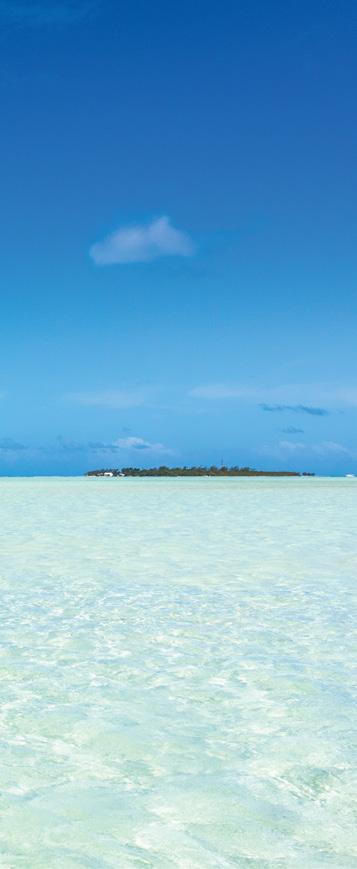
After quickly eating the first slice I reached for the second and that’s when I heard Milan say, in a fairly stressed tone, “There’s an enormous GT in front of the boat.” Without being ready to fish, my initial thought was that we had no chance. Gingerly, I stood up to have a look for myself and that’s when I caught sight of a giant blue shape sitting stationary in the current. “Oh shit, a gift from the fishing gods!” was the first thought that came into my head. I quickly got my 12-weight out of the rod holder, stripped 70ft of line off the reel and began casting my fly in its direction.
My nerves were pretty shot at this point as I had been trying for a while to seal the deal with a sizeable metre-plus GT and I knew that, as opportunities go, this was as good as it was going to get. I duffed the first shot (yes, this happens to us guides too). I then collected myself, slowed my casting stroke and sent out the right presentation way long and ahead of the GT. I waited for the fly to drift toward the fish and then began a long continuous retrieve. The fish eventually acknowledged the fly and began kicking towards it, slow and determined. I then sped up the retrieve a tad. Somehow the fish covered 30 feet in a blink of an eye and before I knew it this massive bucketmouth exploded out of the water, and I was finally connected to a real giant of the species.
Now, remember the oily pizza slice? My hands were covered in oil and no matter how hard I tried to close my hand around the fly line I just couldn’t get any purchase and the line just kept sliding through my hand. In a recurring dream I often have, I’m playing cricket and opening the batting. The bowler begins his run up but I just can’t open my eyes. Like a bad dream, this scenario felt exactly the same, except there’s no happy ending, no awakening. After about five seconds of sheer terror as the fly line zipped through my fingers in a blur, I was left with slack line and silence which was only broken by the click click of a lighter as Milan lit himself a ciggy. A wave of nausea mixed with anger flooded through me as I quickly reeled in my line.
The only thing I could come up with was. “Fuck this pizza man! I can’t believe I just lost the fish of a lifetime like this. Milan, I’m done for the day. You’re up!”
HOW HARD I TRIED I JUST COULDN’T GET ANY PURCHASE ON THE FLY LINE.
It was a pretty dark night and we were spread out along the bank, fishing with cloud cover under a new moon. I heard the unmistakeable GNOEFFFF! sound of the kob smashing my fly before I felt the eat. There was a split second or two where this massive sound reverberated through the quiet, dark night and then the line in my hand went tight. I set the hook instinctively, a straight strip stick set. I think I was fishing a 20lb fluoro straight leader which was, I now know, obviously too light, because I set the hook too hard. Or, to really analyse it, I set and then held on for a split second too long when I should have let the fish have its head to start the fight. The result was that the tippet exploded and because the kob had eaten the fly so close to shore on the spring high tide in the depth of the night, the fly line flew back through the night to land in my lap. I don’t remember if I tied on another fly after that. I think I just packed up, sat down and sulked in my misery.

I run through what I could have and should have done differently over and over again. There was no squiggly tail on the leader where it parted. Was there a wind knot? Possibly, because I was throwing a Spongebob in the darkness so it could have twisted and that’s where it could have broken. But it was not a knot failure. It was just the line that parted.
I have caught smaller kob on the surface in the dark since then, but nothing near that size. Having heard the eat and felt how aggressively it ate, I keep thinking how big that fish would have been. I can still hear the gnoeff and feel the line ricocheting back at me. I think about it ALL the time. I still lose that fish and I think about what could have been, what should have been and what is and what was. That’s why it hurts so much. Brains like loops and that’s the fish that I lose again and again in my head.
A lost fish that left in me a lot of pain was a GT on one of the Sudan atoll flats. I was in the perfect spot and everything happened textbook-style. A GT cruising on a big stingray’s back came straight to us. I placed the fly ahead of us, it ate, I hooked it and it raced across the sandflat. Then it popped the Airflo GT floating line. Jeff and I blanked on some of those days, it was a really tough trip to the tropics with pumping wind on some of the days and we had to stay on the mothership. It was one of those typically difficult-to-navigate trips where you only get to fish some
days, on others you don’t even catch a fish. We bled. So, to lose a fish like that – which would have been my first big GT on foot – because of tackle failure really, really left a hole in my heart. Ja. I also realise that having been back to the tropics and to the Seychelles since, you don’t get many shots at GTs on sandflats, especially not big GTs over 85cm. After a while I realised that was one of the GTs that might have been the most memorable fish caught on a sandflat in my life. It’s a super-shit feeling and I don’t think I will ever get over it.
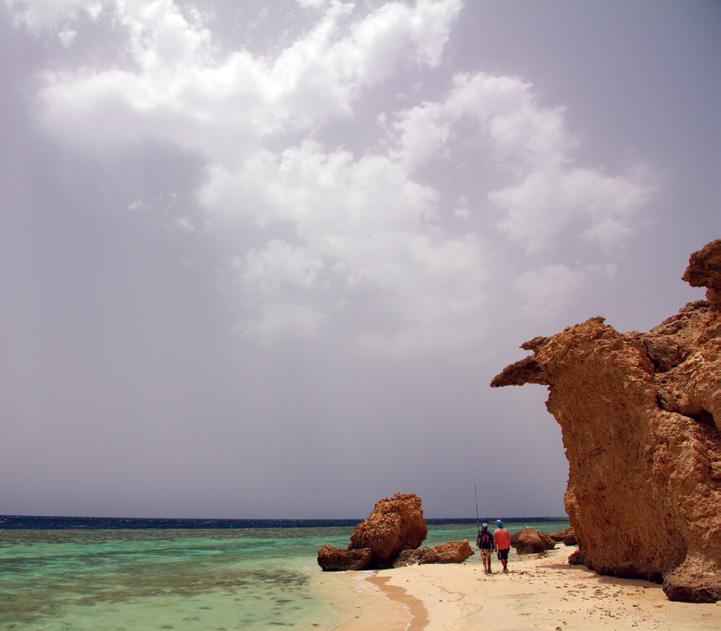
IT’S A SUPER-
FEELING AND I DON’T THINK I WILL EVER GET OVER IT.
In 2013 I went on a Reef Raiders trip to Oman which is something No Boundaries puts together, generally with guys from the fishing industry. The plan was for me to try and get an enormous GT on fly. We headed off to the Hallaniyat islands off Oman. The scale of the Hallaniyats is quite deceiving. If you look at them they seem pretty walkable but, in reality, to get to the next bay some of the peaks you have to go over are 1 000ft or more. The shore break is enormous on some of those islands, so the guys would drop me in the water behind the shore break. I would jump in and swim through the waves to get to the beach. For the first few days it was a novelty, but by day eight, nine and 10 I was pretty gatvol of arriving on the island sopping wet and full of salt. Eventually I was packing everything in my backpack, jumping in the water in my boxers, swimming to the beach, using some fresh water to wash myself off, drying off and then putting my clothes back on.

I think I spotted my first GT a few days in on the islands. While chasing some parrotfish, I was standing on a rock looking down and I looked directly onto the back of an enormous GT of around 50 to 60kg sitting in a cleaning station where I could see the little cleaner fish going in and out of its gills. I lay on the rock just watching it and when that fish left, I tracked it for ages. It ran a very distinct route around the island. I thought OK, there’s something to that, so I sat there again and found another fish that came in. Then another. That was a breakthrough. On that day I saw 19 or so fish. But they were not really in a feeding mood. They were coming into that cleaning station. To get a decent shot my only option was to track further down that same stretch of beach to where there was a big dumping shore break. I knew eventually that a fish had to come in through that shore break.
The morning that I left, I had a proper discussion with Stu, a nutter with all sorts of GT tattoos all over his forearms. I had the prototype Wade reel with me and he shook his head and said, “Listen mate, if I was you, you would not catch me dead fishing a prototype reel. I’d go tried and tested.” At that stage I laughed it off, thinking, “It’s got cork and a drawbar drag. Nothing will go wrong. I will be fine.”
I had just been dropped off and had swum onto the beach that morning, so I was still in my undies. As I put all my kit down on the beach, I turned around and down a wave came an enormous GT. It surfed the wave all the way into the shore break and then just started kicking along in the suds. I thought, “Right, this is my chance.” I had a big tan semper on, tied on a circle hook. I ran ahead of it, dropped one cast a few metres ahead of it but, because the fish was in extreme shore break with lots of bubbles and sand, it must have had very obscured visibility. When I reset and cast again, I put the fly literally on its head like you should never do if it is clear water. Almost skull-crushed the thing. As I dropped the fly it jumped up and annihilated it. I set the hook and the fish ran out.
I tried to keep it in the suds, but it was huge and there was no chance. It ran out and, funnily enough, I felt it immediately wrap me around a rock but then, luckily, it came the other way around that rock and it was off. The fight felt like it lasted forever, but was probably only a few seconds and I had managed to beat him. He’d stopped running once he came free from the rock. I was fishing a Rio Leviathan so I knew I had the strength there and was holding on like all hell. I had the drag locked up as much as possible and I was holding the spool too. I would walk backwards, retrieve a little bit of line, walk backwards, retrieve a bit of line. The fish at this point was just behind the shore break so I was now getting ready to try and land it. It had one or two kicks left in it. By this stage I no longer had to hold the spool of the reel. This was pre-Hardy Fortuna days when you had to rely on palming and full drag, etc. So I would pull the rod up, retrieve, pull the rod up, and repeat.
What happened next was a ridiculous series of events that happened so quickly. As I was reeling in, the fish kicked
and I immediately felt the reel reverse wind, very quickly, twice, backwards – vhup-vhup! I thought, “Fuck what was that?” Then, “It was nothing, keep going.” The fish had obviously sensed there was a weak point so it kicked again. The reel gave a few more reverse winds and the next thing the reel just let go and went into full free spool. The fish was right there next to me and I knew that if it started swimming it would be game over. Stupidly, I tried to grab the spool and the only thing on that reel to hold onto is the handle and the spool itself. I had been holding the drag like that, but now it was a different story as I did not have the drag to assist me. I basically had a reel with no drag while trying to hold a GT of 50kg+. I was holding as much as I could, but every time this thing would give way. In hindsight, what I should have done was drop the rod, grab the fly line and hand-line the fish in, but I wasn’t thinking clearly and the next time it went around it hurt my hand really badly. I looked down and my whole finger and the base of my thumb was already pitch black. The fish ran, ran, ran and just as it got to the point where the
backing was, I looked up and saw that the foot of one of my snake guides had come off. I watched as, almost in slow motion, the loop on my backing went up and hit the foot of the snake guide. It did not cut the line, but I had a loop connected to a hollow core piece of Dacron and it caught the Dacron and basically just sleeved the entire thing off the fly line. Phooop! I dived into the water and tried to grab it, but the fly line was just out of reach so I just watched underwater as the fish swam away with the remnants of my fly line.
When Stu and the rest of the guys came to pick me up, he took one look at me and my hand and said, “You lost an enormous fish, didn’t you? The reel failed, didn’t it?”
For almost two weeks I spent every single day trying to get that fish, so losing it like that absolutely destroyed me. It took me years to get over it. I still try to not think about it at all. For all the meditation in the world it still breaks my heart.

I was staking out a pool that I knew had a very big resident Clanwilliam yellow that I estimated at between 14 and 15lb. These pools are properly overgrown with a lot of vegetation and big undercut banks. Typically, the only chance you would have of getting a fly in front of a fish like this would be when it changes position from one of the undercut banks and swims across the pool to the other side and another undercut bank. So, I positioned myself where there was less vegetation, but it was still very tricky to fish. I then waited. Within half an hour, and out the corner of my eye, I saw something move from the opposite bank. This fish swam right near the surface towards me and, miraculously, I managed to get a Papa Roach fly a metre-and-a-half to the right of it. It ended up being a good cast and the fish just turned, inhaled the fly and, as I set the hook, it took off. I had two or three loops of fly line out and one of the loops hooked on my chest pack and popped the 2x. Just. Like. That.
There was much wailing and gnashing of teeth from me because you obviously don’t get shots at fish like that often. I didn’t rage. As it happened, I probably let out an expletive or two but I felt very bummed. Any anger I felt, I felt at myself. “What could I have done better?” “Why was I wearing a chest pack?” I never wear a chest pack.
I did not sleep well that night at all. My campmate Andreas’s snoring kept me up, which wasn’t great, but so did the loss of that fish.
I still think about it often. It’s kak. I think about what it would have felt like to see the fish in my hands, what the photo would have looked like, how exciting it would have been to have sight-caught a fish of that calibre. A big sight-caught Clannie is not a very common thing.
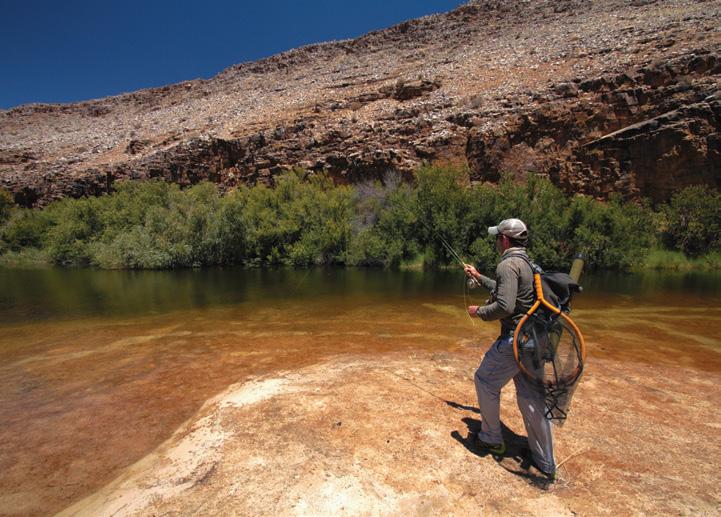
“WHAT COULD I HAVE DONE BETTER?”
“WHY WAS I WEARING A CHEST PACK?”
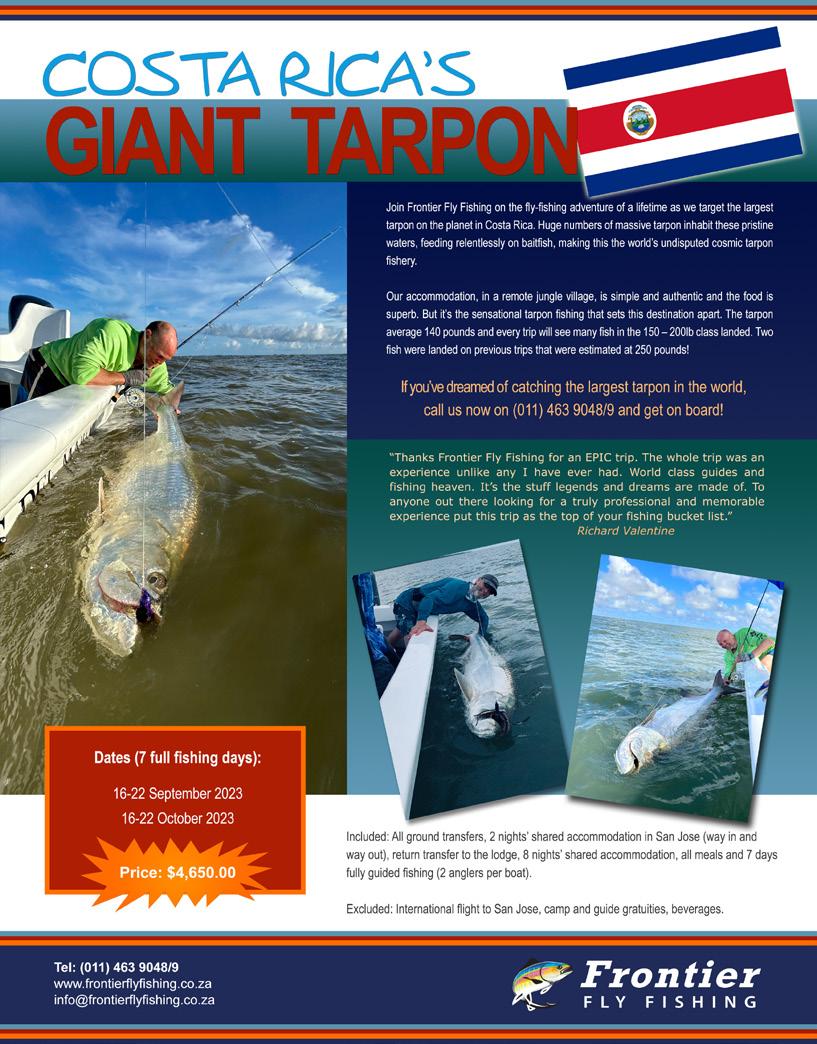


YELLOWTAIL KINGFISH CRUISING THE FLATS BEHIND STINGRAYS, SMASHING BAITFISH AND GENERALLY PRETENDING TO BE GTS? THIS IS NOT A FEVER DREAM OR A PISCATORIAL ACID TRIP, BUT A COMMON DAY’S FLY FISHING IN TAURANGA ON NEW ZEALAND’S NORTH ISLAND. WE CHAT TO LOCAL FLY-FISHING GUIDE AND TRAINED MARINE BIOLOGIST, GIAN BOOYSEN OF KINGS TO BE FOUND (KINGSTOBEFOUND.COM), ABOUT WHAT TO EXPECT FROM THIS SPECIAL FISHERY.

If you saw the name Gian Booysen and surmised that A) not only is he probably not of Māori or any other Pacific Islander origin, and B) he is most likely to have come from South Africa originally, you, Sherlock, would be right. Gian’s family emigrated to New Zealand when he was 11. There are hints of an accent there (especially when talking about fishing) and he still says, “braai” instead of “BBQ”, but we imagine he passes for a Kiwi in most instances.
Gian lives and guides fly anglers on the flats of Tauranga in the appropriately named Bay of Plenty region. There are many reasons it sounds like a special fishery, but the biggest one has to be the way yellowtail (“kingies” in New Zealand) behave there. Whereas we’re used to targeting this pelagic fish on fly off pitching boats at Cape Point, Robben Island or 12 Mile Bank, catching them from the shore in South Africa is nigh on impossible. In fact, it’s one of our Holy Grail fly-fishing challenges, because we have very few places along our coastline where you can realistically get a decent cast out and have the fish close enough to the shore.
In Tauranga, the kingies behave very differently, coming in to extremely shallow water and riding on the back of rays looking for food. Gian breaks down this fishery for us.


The Mission (TM): Describe the area that you operate in.
Gian: Tauranga is a harbour system with two entrances. We’ve got a few deep channels, but the majority of it is just flats. On the southern side there’s a big port. It’s actually one of the busiest ports in New Zealand, so not something you’d expect alongside world-class flats. All of our estuarine and harbour systems on the east coast of
New Zealand are flats systems. Lined by mangroves and sea-grass dominant, they are proper flats systems. It’s only on the western side that they are really deep and channel dominant, and we don’t really have shallows there. Where we are, you can walk four or five kilometres on a flat no problem. Water temperatures normally range from about 16 to 23. It’s definitely not tropical, probably somewhere in that semi-zone.
TM: Is there one specific season for the kings or is it kind of year-round?
Gian: For the kings it’s pretty much October to May. You can find them all year round, though. There are some larger models that stick around through winter but they are not really on the flats and it’s not something one can guide for because you have to be really crazy if you want to put in those hours and try track them down. However, in winter we have silver trevally and snapper and their numbers are quite good. We find the trevally riding on the stingrays as well, like the kingfish and the snapper. There’s probably about a month-and-a-half window where we can find them on the flats, but they are so flighty and the person on the bow has to be prepared for that.
TM: Is there a very specific tide, between October and May, when you know that the fish will be moving? Or is it a little hit and miss?
Gian: Water temperature is probably more important than the tide. Regardless of the tide, because of how strong the kings’ relationship is here with the southern stingray, you can find them generally riding the stingrays even if the moons are at a quarter. So you don’t need a super-push. The exceptions are the big free swimmers. These guys travel alone or in small packs, and these bigger kings like bigger tides when the baitfish are uncomfortable.
“IN TAURANGA, THE KINGIES BEHAVE VERY DIFFERENTLY, COMING IN TO EXTREMELY SHALLOW WATER AND RIDING ON THE BACK OF RAYS LOOKING FOR FOOD.”


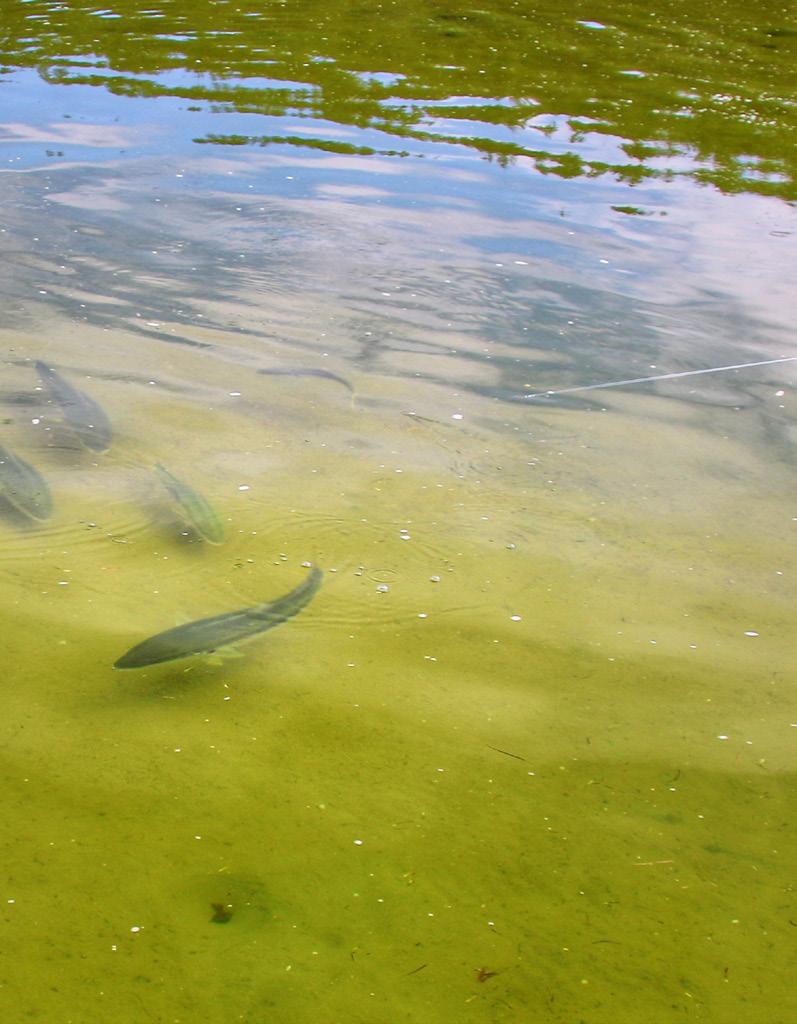
“THE KINGS SIT ON THE BACK OF THE RAYS BECAUSE THE RAYS TAKE THEM TO THE FOOD.”
TM: Tell us a bit about the relationship between the southern stingrays and the kings?
Gian: The rays belong to a class of animals called the Chondrichthyes, and this is the same class that sharks fall into. What the sharks and rays have in common is that they have these small pores around their mouths called the ampullae of Lorenzini. This is pretty much just a pore filled with a conductive gel. Anything that scutters, breathes or gives off a heartbeat or pulse releases a small voltage. The rays and the sharks pick up on this. For example, we’ve got flounders buried under the sand. Rays pick up on the pulse, track the flounders down and head on over to them. The kings don’t have these receptors so they sit on the back of the rays because the rays take them to the food. We also see them on the backs of bronze whalers, big sharks, any of the ray species. There are even cool ones that we see shag, you know, the diving birds? They swim with the stingrays as well, dive down and feed, then come up and just keep following the ray in the shallows. It’s incredible.
TM: It’s interesting about the electric pulse that the baitfish give off and that the rays get attracted to. When we fish for sand sharks on fly in the Western Cape, guys work copper wire into their flies.



Gian: That’s really interesting. If you could sample sand shark prey and have a look at the exact average voltage that they emit and then emulate that, you guys will be on the money. I’ve been trying to catch a bronze whaler on the flats, but have been refused. These are like 2.5-3 metre sharks and they will come up to these big articulated bucktail flies and open their mouths. At the last minute, they seem to sense that there’s something not quite right about them and just turn away.
TM: You just casually dropped “ampullae of Lorenzini” in conversation. We understand you’ve got a background in marine biology?
Gian: I’ve been ocean-besotted since I can remember. As a little kid we would travel around South Africa to wherever the marine biologists were speaking. My grandparents would come with us… everyone. I have the most supportive family. I studied marine biology at Victoria University, which is in Wellington at the bottom of the North Island. The aim was always to guide people onto fish, but also to have a solid understanding of the ecosystem and being able to explain it to people, talk about the food sources, what we look for in the flats from the bait to the health of the grasses. I really enjoy that and I think people enjoy that too.
“IN WINTER WE HAVE SILVER TREVALLY AND SNAPPER AND THEIR NUMBERS ARE QUITE GOOD. WE FIND THE TREVALLY RIDING ON THE STINGRAYS AS WELL, LIKE THE KINGFISH AND THE SNAPPER.”

TM: Interesting that you studied marine biology not to be a marine biologist, but knowing that you wanted to be a fly-fishing guide.
Gian: Absolutely. It was really quite funny because, while I was studying, I had this inordinate passion for marine biology but not always in the same way as my peers. When they taught us about eelgrass and the mangroves, you can just imagine how many questions I asked, because I was thinking, “This is my fishing life that they’re teaching me.” I knew where I wanted to go. That’s why my parents and my partner moved with me to Tauranga from Wellington. They are the most supportive people I’ve ever come across. If we hadn’t made that move, the whole guiding operation would not have taken off as smoothly as it did. It’s really not just me, this story. There are so many people around me that made it happen. I would still like to go and study further, maybe on the relationship between the rays and the kings.
TM: Where did wanting to be a guide come from?
Gian: I was an avid trout angler growing up but, as soon as I touched the salt, there was no going back for me. But why the guiding? I don’t know. I love being outside. I love being on the water. And the big thing is, I love meeting people. I love hearing the stories that different people bring on the boat, their experiences and when they cast and experience
the kingfish, I can relive it through them. It’s almost like I can see their emotions and feel what I felt the first time as they see the tail break the surface, or see the fish come up to attack a popper. We can experience that together as a team working towards a common goal.
TM: Obviously kingfish or yellowtail are pelagic, but are the ones that you get in Tauranga known to come back to the same areas, year-on-year? Are they tagged and tracked?
Gian: I tag every fish. I love tagging. They aren’t GPS tags, just T-bar tags, so the data relies solely on recaptures. As a species, recapture rates with kingfish are pretty good so normally we do get some data back. The population boundaries are smaller than you’d think. From memory, they will stay within about a hundred-mile range. When we tag fish on the flats and revisit these flats, we see what we think are the same tagged individuals cruising the same lines sitting on the same marker poles or on the same rays. They definitely do return. Obviously, there’s that period through winter when I think a large portion of the juveniles leave the harbour and we don’t see them. But then the coming year they will return. I don’t know if this is up until a certain age or sexual maturity when they may be gone on a longer journey, but this is how it seems.
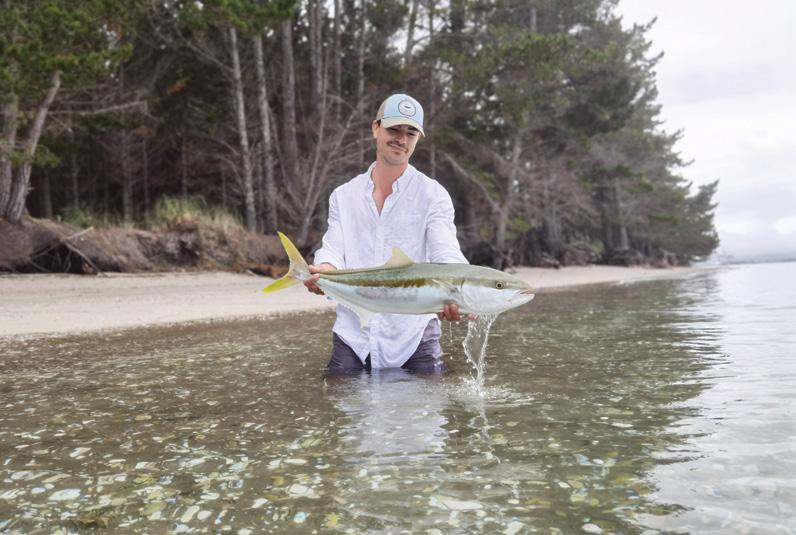
TM: What sort of pressure does this fishery get and how much does good environmental management contribute to the longevity of the fishery?
Gian: I think the regulation is poor. I would love to see something like the Bonefish & Tarpon Trust and what they’ve done for conservation in New Zealand. These harbour systems and estuaries are nursery environments, especially for snapper and trevally, so I would love to see more of a push to look after them. New Zealand still has some very old-school methods going on. People will stake nets in the ground, or they’re Kontiki fishing [Ed: Kontiki fishing is beach longlining using a small raft or float that sets 20 hooks out in the ocean]. Hopefully the mindset will begin to change a little bit and they’ll become more selective. Regarding the pressure on the system, with the recaptures, these fish seem willing to eat a fly a few times, provided there’s proper handling and catch and release. That’s a great plus for the species. Fly fishers are getting more and more interested in it. Fish are seeing more flies. Both anglers and the fish are having to adapt. As a guide, it’s just another challenge. You have to outthink the fish and the other anglers.
TM: Is it the kind of fishery where people actually have to have a boat or some kind of flotation, or can they DIY it on foot?
Gian: You can DIY it on foot, it’s just much harder. If I were to travel here, I’d definitely try and get a guide for a day.
TM: Tell us about the extra-size bucktail flies you mentioned. Are these Beast flies?

Gian: Yeah, it’s a Beast. Even though it’s really sparse bucktail, it’s still not the easiest fly for all clients to cast. And it’s not the most effective thing but, for the larger freeswimmer kings, it can be pretty good.
TM: What’s the rest of your setup?
Gian: It depends what we’re doing. We fish 7- to 12-weights. On the flats, we’re mostly with a seven, eight, or nine if we’re throwing little crabs or if we’re throwing small baitfish. We use nines or 10s for the structure, the marker poles, and then 12s if it’s the big sharks or the big free-swimming kingies.
TM: They go for crabs as well?!
Gian: The kings range from 60 to 130 centimetres, which is a big range, and they display a range of feeding behaviours. The tailing fish would be closest to say a bonefish mixed with a permit. They can be equally as fussy as a permit, but also tail happily like bonefish at times. Those free swimmers are just like GTs. Same family, same behaviour, same aggression.
“IT’S A BEAST. EVEN THOUGH IT’S REALLY SPARSE BUCKTAIL, IT’S STILL NOT THE EASIEST FLY FOR ALL CLIENTS TO CAST.”
TM: How strong are these kingies compared to the trevally?
Gian: Well, I’ve caught GTs and it’s a big call, but I would say they’d pull a GT backward. It’d be an interesting experiment. The kings are sleek and submarine-like. The whole thing is muscle and a big tail. They’re pretty powerful. The silver trevally are also just balls of muscle. They fight like crazy, but the cool thing about them is they have really soft lips. So even though they fight so hard, you have got to be really careful with the fight as well.
TM: Is it all sight fishing or do you have to blind cast at times?
Gian: It’s up to the angler. I always prefer people to cast, even if they are unsure of things. But really, it can be all sight fishing if you want it to be.
TM: Do the kings go for poppers?
Gian: Absolutely. They love a bubble trail, they love noise, and they love poppers.
TM: Have you ever seen or caught sea-run brown trout or salmon while hunting kings and snapper?

Gian: I took someone out on a little flat system in Wellington and we were fishing the edge of the flat when he hooked something that we assumed was a kahawai. Sure enough, it was a salmon just cruising the edge of a flat. But up here in these northern waters, we don’t see them much. I think it might be a bit warm.
TM: Can you describe a day out with you from start to finish?
Gian: I’ve got a few different launching facilities but, for my favourite one, I like to be there as the light dawns and the doves, tui, starlings and fantails are all waking up. The volume is deafening and I think it’s quite nice for clients to be greeted by that. I always start the day asking the client if they have certain goals. That determines the day’s direction. If it’s an angler wanting to chase kingfish, we get the boat in the water as the sun is coming up and we head for some structure that we hit in the low light
just as we start to see into the water column. Then we go onto the flats to look for kings. The mornings can be really good for tailing fish. As the light comes in, we start seeing the rays. Not all the rays carry kingfish, so we have to check all the rays out until we find them. We might see kahawai schools pop up and straighten our lines out there and just get people used to casting to moving targets. Then, when the clients’ nerves have settled, we can do the kingfish thing properly. You never quite know if you’re going to find a ray rider or a free swimmer. We have coffee around 10am at a picturesque spot, but always keep looking. We also break for a nice lunch that I make for everyone but, of course, that’s always when the fish show up. The day is pretty relaxed. I obviously love fishing, so I don’t say we have to get off the water at a specific time. We just go by the day. If they catch that amazing fish at eight in the morning, then we are pretty chilled. We just relax and normally head back whenever people have had enough and we’ve lost the light.
SMITH: LOW LIGHT IGNITORS

With my Smith Low Light Ignitors, I can see on the flat at 6am which is amazing. They are unbelievable sunglasses. They have a yellow shade, but it’s almost like the contrast toggle is extreme. As soon as there’s a sliver of light in the morning, you can see and identify shapes. It’s really given me another hour to an hour-and-a-half of fishing. smithoptics.com


For me there are a few considerations with line selection like the flat and its average depth, how we are going to approach the fish and the client’s casting ability. When it comes to lines, it’s Scientific Anglers all the way! I have tried most manufacturers but these guys are just the GOATs. I favour both their full floaters (like the Redfish) and their intermediate lines (like the Grand Slam). They are durable, have good textures and good tapers. I’m a big fan boy. scientificanglers.com
TOP TIP: Test your knots. Test your knots. Test your knots. It’s amazing how many people don’t know what knot they like, don’t understand the strength behind the knot they use or what its proper purpose is. You can ruin a whole leader system just by using shit knots. It’s the main thing so go grab a scale and test them. Test the breaking points, write them down and find something good that works. For my leader system, my tops are normally Blood knots, then it’s back-to-back Uni knots and then for the loop it’s always a Lefty. The top loop might be a Perfection Loop, but the bottom one is always a Lefty. On the 8-weights, we taper the leader down to 16lb. On the 10-weights, it’s just to 30lb. We’re not going for strict IGFA rules, we’re just having fun.
GETTING THERE: Fly in to Auckland and get a hire car. Tauranga is just two-and-a-half hours’ drive from Auckland. Your other option is to take a half-hour flight from Auckland to Tauranga.
STAY: There are heaps of AirBnB options, but if you want a nice hotel on the beach, check out the Trinity Wharf and The Clarence Boutique hotels.
EAT & DRINK: There’s a big waterfront with heaps of different places from luxury seafood places to your American-style big portion of ribs type places like Lonestar Café & Bar, which is a nice place to go and just chill.
“THE KINGS ARE SLEEK AND SUBMARINE-LIKE.
THE WHOLE THING IS MUSCLE AND A BIG TAIL.”



This lust-worthy new range from Orvis made us think of Oblivion, the Tom Cruise flick circa 2013 where he buzzes around an inhospitable Earth in 2077. Not that we want to imagine Earth becoming a post-apocalyptic wasteland, but because the styling and functionality of these new packs make them not only look like they came from the movie, but that they could handle those conditions too. Literally seamlessly designed in 840-denier ballistic nylon, they put the “fort” in comfort, but still keep the ergonomics of a fly anglers as their priority. First up, the 30L (regular) backpack, for on-the-go hoarders. What if it rains? What if I’m hungry? What if I need to attend a virtual meeting mid-beat? This cavernous beast has you covered. Breathable foam shoulder straps and back-padding assist with hauling the kitchen sink, while lumbar straps keep your vertebrae in place during all of that extreme boulder hopping. Equipped with rod tube straps, a net scabbard with enough space left over for your vodka-soda canteen on the side, this monstrous submersible has a blow-out free, #10 TIZIP® MasterSeal zipper that opens up a huge main compartment with internal hanging baskets for your tippet and biltong. Although largely for the same application, the 20L roll-top backpack might offer some peace of mind to those more reliant on the added security of a roll-top – if not for function over form, it might just boil down to preference.
Lightweight marauders might enjoy the sleeker, more accessible design of the 14L sling. The strap holds your nippers and haemostat for on the go rigging modifications and with an elegant dorso-ventral fling, you can access the in-built Tippet-Whippet, fly patch and main compartment. This has enough space for your basic fishing trinkets and potentially a smaller camera. In almost the same size category, the 10L hip pack is another more compact solution for those with blown-out spines. It sports the Tippet Whippet, a fly patch, and a nifty hipped netscabbard along with a generous main section with internal pockets. Those with no butt/small glutes can make use of an optional shoulder strap. orvis.com, flyfishing.co.za


Saltwater fly fishing has a new heavyweight contender. Sage’s ENFORCER has been KLAPPING gym in the off-season boet, possibly even indulging in a little Vitamin S, because with 50% higher drag than its predecessor (the Spectrum Max), the Enforcer is not stuffing around. Bonefish wants to run? The 8-weight Enforcer says no. Tarpon wants to free-spool you? The 12-weight Enforcer tightens the drag and shakes its head first before the poon can shake its own. With improved O-rings and drag plates for added indestructability, if saltwater fly fishing is a giant nightclub, then this might just be the tough as nails bouncer blocking the door. farbank.com, frontierflyfishing.com

Finally, a revolution to the tedious process of switching fly boxes, and replacing flies one by one. C&F Design introduces the 12-Trout Guide Boat Box. “But I don’t own a boat..” you might say. Well, this is not just a boat box. Think of it as the ultimate on-the-fly switcheroo system. It can live on your boat, in your car or in your cave at home. Depending on what fishing is imminent – simply swap out your selection to either the System Case, System Chest Storage or System Fly Patch. The Boat Box comes with large size system foams for trout – 3 x streamer inserts, 3 x attractor inserts, 3 x standard inserts, 3 x midge inserts. c-and-f.co.jp, frontierflyfishing.com

A large part of the appeal of permit is how bloody hard they can be to catch. Apart from the usual litany of things that can go wrong while fly fishing for any species, with permit you have to deal with their high-admin personalities too. RIO’s Elite Permit line is specifically designed for this picky bastards, so at least you have one less thing to worry about. Its low-stretch, ultra-slick performance means it loads at close range with an easy casting taper. The weight distribution is designed to give soft presentations to spooky fish, but it handles weight well so your crab patterns go where you intend. Got a second shot at a disappearing permit? The long back taper allows you re-load fast for another cast. Built on RIO’s low-memory DirectCore, the Elite Permit fly line stays stiff in extremely hot conditions yet is easy to stretch and lies straight on the water. The SureFire colouring system lets you track line length, and maintain distance and accuracy control. farbank.com, xplorerflyfishing.co.za

Storage is king, but so is sleekness, comfort and price. Xplorer’s new 2023 range addresses the lot. At the top of the pile is the Adventure PRO Vest Pack which offers a smorgasbord of features but won’t break the bank. Expect the convenience of plenty of pockets with fold-down workstations, coil retractors, holders and tabs for tippet and tools, and the minimalist mesh backing of a traditional fly vest. All of today’s fly fishing goodies have a home on this multi-faceted vest. xplorerflyfishing.co.za
XPLORER - SMALL FRY FLY VEST
Playing dress up with your weans comes with new options in 2023. Kitted out with a miniaturised version of the Spring Creek Fly Vest, your mini-mes can feel just like mum and pop in their Xplorer Small Fry Fly Vest. But don’t be fooled, this is not dress-up. This vest still features all the functionality kids from ages 5 to 12 or small adults might need. xplorerflyfishing.co.za

XPLORER - SPRING CREEK FLY VEST
A more affordable option in the range, the Xplorer Spring Creek Fly Vest keeps in line with a well-trodden legacy. Why fix it if it ain’t broke? Simply put – it’s a fly vest with ample space for your boxes, your tippet, some dry stuff and some sinking stuff. There’s a spot to hang your nippers and some kind of sharp nose pliers. There’s another spot for drying flies and a strap for your rod when re-doing your leader setup. This vest covers all bases, demonstrating the beauty and effectiveness of simplicity. xplorerflyfishing.co.za








Releasing on April 1st (this is no prank), Nike’s latest fly fishing-related release sports a nod to their Oregonian heritage, just like the rainbow trout. The Nike Dunk Low “Rainbow Trout” sneakers feature trout scales on the side and toe panels, complemented by a dark green suede overlay. The iridescent swooshes have been modified to resemble a barbed hook, and a variety of colour explosions highlight other details of the shoe. nike.com
Not a cooler-box, but certainly cooler than your tool box. Fly Project’s new bits-and-bobs storage container is designed specifically for boat anglers. The bomb-proof box includes a main void to store all sorts of bigger items, with smaller secondary compartments perfect for any accessories. The inside of the lid is equipped with a dual foam-velcro pad to secure drying flies, alongside two transparent utility boxes used for storing leaders, tippet and other goodies. When closed, the watertight copolymer box is secured by two snap-down clips. The lid features two security rings, which can be locked and/or tethered to a boat. By the looks of it, it might even keep a beer cool too. flyproject.us

“NOT A COOLERBOX, BUT CERTAINLY COOLER THAN YOUR TOOL BOX.”









People often put rods in two categories - ones that are great for casting but that break easily and others that cast like broomsticks, but can horse big fish in with ease. With their new Sage R8 range, Sage claim to have increased the fight in the rod by adding 25% more strength per weight. That allows you to land fish faster and practise better catch and release. But does that mean it’s a broomstick? Nyet, comrade. While still boasting an elite feel-oriented cast, the Sage R8 Salt has a taper that delivers a fine touch and accurate presentations even in the heavier weights. Translation – this sounds like a Goldilocks-zone rod where everything is just right. Available from 6 to 12-weight (with two variants in the 12). farbank.com, frontierflyfishing.com

For the working traveller who always packs a fly rod, we present to you Patagonia’s Black Hole 25L Backpack, a pack that’s as comfortable at a hot desk as it is at a honey hole. Made mostly from recycled materials, it features a main tech-friendly storage compartment, with space for a 15” laptop or a large hydration bladder and hose port, depending on your needs. A smaller front pocket allows quick access for storage of essentials. An all-round durable water repellent finish gives the body and lining some protection from the elements. atagonia.com, xplorerflyfishing.co.za


New Howler Brothers cap dump at Upstream Fly Fishing! The El Mono Snapback and Electric Snapback offer a more traditional trucker style (old school curved brims), with a medium crown height, and hi-tech glare-reducing (navy) under brim. A species feature is highlighted in the Creative Creatures Roosterfish Snapback, a 5-panel captain’s hat that moulds to any shape, with an adjustable snapback and pliable brim . upstreamflyfishing.co.za, howlerbros.com

“A FINE TOUCH AND ACCURATE PRESENTATIONS EVEN IN THE HEAVIER WEIGHTS”

If squinting through slitted eyes with a headlamp halfilluminating a disproportioned fly is your thing then great, but why suffer? Like your ex in that weird recurring dream, Wapsi’s ProLite Fly Tyers LED Lamp Magnifier has 18” flexible arms. That gives you a wide angle of bright light, plus there’s the natural-coloured magnification lens to help you see your work better. When you see better, you reduce eye fatigue when tying flies meaning you tie more flies, get better at it and enjoy your fishing more. Well, that’s the theory anyway. The ProLite Systems include a builtin storage tray, bench-mounting clamp option, and LED bulbs that stay cool. You can opt for the light/lens combo, or a dual LED version specifically intended to improve lighting for photography of a finished fly. Your fans on the ’Gram expect quality. xplorerflyfishing.co.za, wapsi.net


A simple high-quality hoodie or branding for the world’s most mysterious ape-like creature? Yeti’s Brushed Fleece Logo Pullover Hoodie might just be both. Warm, snug and bold, never before have we wanted to turn ourselves into walking billboards for the Abominable Snowman. upstreamflyfishing.co.za, yeti.com
A bad workman blames his tools, however you’re unlikely to find things to blame on this lean, mean, cutting, plying, saltwater resistant, non-slip grip machine from Dr. Slick. The anodised aluminium frame Squall pliers has heat-treated stainless steel jaws and HR 70+ carbide side cutters that can slice through 60lb tippet, braids and synthetic lines in a flash. Includes a hex key, replacement cutters with jaws, full-swivel coiled lanyard and a clip-on moulded holster so you can live out your Magnificent Seven dreams. drslick.com, upstreamflyfishing.co.za

“WARM, SNUG AND BOLD.”
“LEAN, MEAN, CUTTING, PLYING, SALTWATER RESISTANT, NON-SLIP GRIP MACHINE.”






Shop online at www.xplorerflyfishing.co.za



COME AND XPLORE OUR NEW CONCEPT STORE • UNIT 4 MARSEILLES PARK , 25 MARSEILLES CRESCENT, BRIARDENE, DURBAN NORTH

The Xplorer Concept Store has every single Xplorer product, plus a wide range of products from the brands below. Pop in for a cup of coffee, have a browse around and see the complete range of products, never seen in one shop before. Open until 5pm Mon-Fri and until 1pm on Saturdays.


Like most fly anglers, we like to day dream about having an indestructible 4x4 that can take us anywhere to fish. And, like your average seven-year-old (or billionaire), in those dreams we have unlimited dosh to design our own. Industrialist Sir Jim Ratcliffe (Britain’s wealthiest man) didn’t have to dream. This is a guy who is rumoured to be buying Manchester United, which means that when it comes to dream cars, he has the loot to actually do something about it.
The result is the INEOS Grenadier. We know, we know. At first glance it looks a lot like the classic Land Rover Defender. In a way, that’s half the point and a large part of the story of Jim’s vehicle. When Land Rover ceased production of its legendary Defender series in 2016 after nearly seven decades, Jim was bleak about it so he allegedly tried to buy the tooling rights to the Defender from Tata who own the Jaguar Land Rover (JLR) group. They turned him down so, as billionaires do, Jim decided he would rope in the best automotive engineers, get the best components and build his own (better) no-frills nofuss 4x4 from scratch.

After approximately $1.6bn, a legal battle with JLR and several years of global supply-chain setbacks, the INEOS Grenadier is about to hit the dirt near you. Named after Jim’s favourite pub, the Grenadier has enough of the Defender shape to be familiar but, with plenty of modern
trappings, functionality and comfort, it is very much its own car. We went for a drive in one recently and can confirm that, what with the numerous switches, toggles and buttons in the front, it’s a little like being in the cockpit of a Boeing.

According to Barry Havenga, the marketing manager of INEOS Grenadier South Africa, it was important to Jim that instead of touch screens all over the place (there is one upfront for your phone/music), the control buttons in the car needed to have a solid tactile feel. That’s because when you are bumping over tricky terrain, attempting to hit a small spot on a touch screen is a lot more difficult than pressing a proper button. If you’ve ever tried to call your significant other while rumbling over potholes on Beyers Naude and eating a KFC Zinger, you’ll know that fat greasy fingers and slight bumps do not a happy marriage make. Thanks for thinking of us Jim. We feel seen.
The obvious, old school, Defenderesque touches like round headlights, flat fenders and boxy proportions aside, the Grenadier is a smarter, much more modern car than its spiritual automotive ancestor. Take the black strips on the body which are utility belts that can take up to 45kg of clobber; or the lockable 20-litre storage box in the reverse-mounted spare wheel; or the inside of the boot door that hides a table for impromptu coffee breaks. All versions sport an 8-speed automatic transmission with manual override. At this stage you can pick between BMW 3.0L Turbo Petrol or BMW 3.0L TwinTurbo Diesel Straight-Six Engines (an EV vehicle is apparently in the works too). INEOS Grenadiers come
“THE GRENADIER IS A SMARTER, MUCH MORE MODERN CAR THAN ITS SPIRITUAL AUTOMOTIVE ANCESTOR.”
with permanent four-wheel drive, a full box-sectioned ladder frame, a galvanised steel body, heavy-duty coil suspension, two-speed transfer case, centre differential lock, 30/70 split rear doors, towing eyes front and rear, an overhead control panel, offroad and wading modes, and a ton of other features.

As for colours, there’s a range like Scottish White, Magic Mushroom (shuwoo), Eldoret Blue and Inky Black. Our favourite is obviously the Selá Green, named after the famous Icelandic river.
South Africans can get their hands on Grenadiers from May this year. Anticipate a three-month waiting list and a starting price of around R1.5m. ineosgrenadier.com

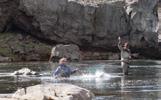
Jim Ratcliffe is a keen fly fisherman and has invested heavily in protecting Atlantic salmon through the Six Rivers Project, a not-for-profit salmon conservation programme that seeks to reverse the decline of the Atlantic salmon population. The rivers in question in north-east Iceland are the Hofsá, the Selá, the Midfjardara and the Sunnudalsá. Find out more at sixrivers.is.


MISSING A COPY? GET YOUR BACK ISSUES OF THE MISSION AND A RANGE OF NEW LUCKY CAPS AT THEMISSIONFLYMAG.COM






 THE MISSION 5-PANEL - BLACK - R550
FLAT DOG ROCK TRUCKER - BLUE/GREEN - R340
THE RETRO TRUCKER - BLACK - R400
Bod and Kimba testing the new Mission 5 panel, leervis at Zandvlei.
Photo Brett Bellairs.
THE MISSION 5-PANEL - BLACK - R550
FLAT DOG ROCK TRUCKER - BLUE/GREEN - R340
THE RETRO TRUCKER - BLACK - R400
Bod and Kimba testing the new Mission 5 panel, leervis at Zandvlei.
Photo Brett Bellairs.
A PREMIUM ROD AT MID-TIER PRICING? EWAN NAUDE WAS NEVER A SCOTT AFICONADO BEFORE TESTING THE NEW SCOTT WAVE 8-WEIGHT BUT, WITH PAY-DIRT PERFORMANCE AT A REASONABLE COST, HE MAY JUST HAVE CONVERTED TO BARTCHIISM*.
Photos Ewan Naude, Garth WellmanIthink it was Confucius or maybe Ye who said, “They must often change, they who would be constant in happiness or wisdom.”
I’m not one to fall in love with my fishing tackle. Of course I get a good dopamine hit when something new arrives and it’s all bright and shiny, but what’s bright and shiny eventually fades and all that matters is that said item does its job. If my chosen gear, be it a rod or a rain jacket, treats me well, I’m very unlikely to make a change just for the sake of it. I typically mate for life but, as some of my farming friends say, “Sometimes a bull jumps the fence”, and the Scott Wave made me leap.
For some reason, up until this point, I had never even cast a Scott rod. It wasn’t a conscious choice, I had just never crossed paths with the brand although my Feathers and Fluoro mates, Peter Coetzee and Fred Davis, crow from every rooftop when it comes to all things Scott. It was Fred who put out a message to our group asking if anyone would like to test the new Wave. Taking Confucius/Ye’s words to heart and in desperate need of a fishing gear dopamine hit at the end of a brutal year, I purchased one. An 8-weight rod is well suited for estuary fishing and with the Christmas break agonisingly close, I was keen to test this rod on the Eastern Cape’s estuarine river dwellers. I have no doubt that this rod will also be the perfect largemouth/Clanwilliam yellowfish streamer tool.
Having spent the past few weeks with this rod I can honestly say that I feel a sense of sadness that I’ve let so many fishing years go by without knowing the brand. I say “knowing the brand” because it’s not only about the tackle but what they stand and strive for that captured me. It’s a company run and staffed by passionate fisherpeeps and the fact that every rod is unique, right down to the
handwritten Scott insignia, is pretty special. Of course, they are a commercial enterprise but their passion for rodmaking and putting anglers at the centre is so refreshing in a world where bottom line tends to trump all. They tell a story and the fact that they make exceptional fly rods almost seems like a bonus.
The Wave is marketed as a mid-tier rod and is priced accordingly at around $675. After fishing this rod for a few weeks there is absolutely nothing mid-tier about it. It performed as well, if not better, than some of the outand-out premium rods I own and the components from the cork to the guides are of premium quality. I love the understated simplicity of the unsanded blank and how the reel seat works with the simple blue wraps. I guess the question is then, ‘What would make this rod a ‘top-tier’ stick?’ I don’t really know, to be honest. Splitting hairs, perhaps it’s the guides but, in my view, the Wave should be seen as a premium rod. It’s just that it’s an affordable one.
I pared the rod with the Lamson Guru -7+ reel (another sneaky deviation from my standard Shilton reel purchases) and a Scientific Anglers Amplitude Smooth Infinity Salt floating line. I mostly fished estuaries over the December break and spent a lot of the time fishing heavily weighted Clousers on a long leader. This “jig-and-drop” method is a great trigger for many species if fished correctly, and it has served me well. The rod performed effortlessly casting the heavy flies, even in a stiff wind. The method used didn’t call for accurate casting on a regular basis but when I needed to aim at something specific I did feel that accuracy was good, even at long distances. I was surprised at how fast the blank was, which suits my casting style and worked well for me.
“THE WAVE IS A PREMIUM ROD AT A MID-TIER PRICE. IT LOOKS GREAT, FISHES GREAT AND THERE REALLY IS VERY LITTLE TO CRITICISE.”
I got to test the casting ability of the rod way more that the fighting ability, but I did manage a few fish and was particularly chuffed with a good dusky kob caught on a weighted, jackal fur shrimp meant for a deepwater grunter. Although not a monster, the fish did put a proper bend in the rod and I could feel the backbone when applying pressure. I don’t doubt that this rod would stand up well to much bigger quarry.The only “criticism” that I have is that the rod fishes slightly lighter than I’m used to in a fastaction 8-weight, but is perfectly well suited for general estuary work. This didn’t bother me, but those anglers used to rods that are heavy for their weight may struggle with this. As mentioned, when buying the rod I had yellowfish in mind and I think it will make a great crossover into freshwater for this species. I look forward to swinging some streamers in river tailouts with the Wave.
The Wave is a premium rod at a mid-tier price. It looks great, fishes great and there really is very little to criticise. I’m certainly keen to try some of the heavier rods and I hope they match the 8-weight for performance. In researching the brand I genuinely got a warm fuzzy feeling, and I like warm fuzzy feelings.

In the classic Australian cinematic masterpiece, The Castle, lawyer Dennis Denuto references the “vibe” of the Australian constitution. In summing up, Scott is about rods but in Dennis’s words, “It’s about the vibe of the thing.” I’m glad I jumped the fence and experienced what I’ve missed out on for so long.
 *The gospel according to Jim Bartschi, owner of Scott Fly Rods.
*The gospel according to Jim Bartschi, owner of Scott Fly Rods.
The first fish I remember “catching”, I hate to admit, was a “goldfish” (probably a rare koi) which, to my surprise, I speared with an absentmindedly thrown reed in the Japanese gardens in Durban. The first fish caught with line and hook was either a trout or a bream. I was around five at the time. The bream I caught with my uncle in Zimbabwe in a dam somewhere outside Bulawayo. We caught them on worms dug up in the garden that we suspended under a pencil float, thrown into a spot that had been recently chummed. They came out in their dozens. The trout was caught at a dam at Dirksen’s hatchery in Dullstroom, with a terrible-looking Walkers Killer nymph on a tippetless leader that had been progressively shortened to the point where it barely passed through the eye of the hook.
I’ve called three places home: Johannesburg on three different occasions, Kloof in KwaZulu-Natal between two Joburg sojourns, and Cape Town on two occasions, one of which is current. It was as much of a whirlwind as that suggests.
Jobs I’ve held include being a clown in Garlicks department store (fortunately of very short duration); the first-ever (I think) male chambermaid (and waiter) in a hotel in Sidmouth in the south of England; a maths textbook illustrator; a part-time design lecturer/studio master in the Architecture department at the University of Cape Town and currently, an architect.
With my two kids now grown up, a typical day no longer involves school lifts. My wife and I have an architectural studio attached to our house so we start work at eightish (earlier if there are deadlines) after coffee/tea in the garden. The working day is spent designing, drawing, doing admin, seeing clients, visiting sites. My wife and I do tai chi one morning and I play hockey and/or tennis two or three evenings in the week. I walk the dog in the forest with my wife every other evening. In winter I try to get in an early morning surf.
The Du Toitskloof streams have been my home waters for 44 years. More recently it has been the Upper Olifants in the Witzenberg Valley where we had access to some very special brown trout water.
I fish on my 20-odd bamboo rods on both streams and in estuaries, except when throwing big flies. Bamboo is a wonderfully sensitive material in lighter line weights (000-5-weight) and rod lengths up to around 8ft max. It is a real treat to fish bamboo as each rod is a character. Bamboo can, however, get a bit heavy in hand for a long day’s fishing with heavier lines (6-weight+) and longer rods (8’6”+). So I go to graphite for those occasions.
The best advice I have ever been given is that there is an ebb and a flow in the tide of human relations.
I am most proud of having found the wife I have. Otherwise, I have moments of pride rather than being proud of a single thing. I do believe pride comes before a fall so I try to keep it in check as best I can.
The best party trick I have ever seen is not really a trick. I spent one evening around a campfire at Victoria Falls on a full moon with some Deadheads (Grateful Dead followers) I’d met there. One of them was a gifted storyteller who had us enthralled, mesmerised and intermittently in hysterics for hours with an incredible evening of storytelling.
I have had to work really hard at trying to play a musical instrument. I don’t have a good ear but can, at least, now entertain myself on the guitar. I started playing when in a plaster cast and boot for months after snapping my Achilles tendon.
I find 3D spatial visualisation and implementation comes naturally. Good thing, since my profession as an architect is about exactly that.
“THE BEST ADVICE I HAVE EVER BEEN GIVEN IS THAT THERE IS AN EBB AND A FLOW IN THE TIDE OF HUMAN RELATIONS.”






The most satisfying fish I ever caught was a 16in fish high up the Jan du Toits River that I spent at least two hours working on. It was in a tricky lie that required a very precise cast at a precise moment. I have spent rapt hours alone and with others pursuing individual fish on that stream.
One place I have to return to is Mdumbi on the Wild Coast, where there’s an incredible surfing wave and great fishing off the rocks.
I got into bamboo rods when I was a kid and my dad gave me a 7ft 4-weight Walker Bampton that I loved to fish. It was a dreamy, smooth casting rod (I later worked out it was based on a Garrison Taper). I had, however, picked up a bad habit of inverting my first (fibreglass) rod and pulling down branches in which I had lodged my fly with the reel. While bamboo is a tough material, the leverage on a fine tip was retrospectively, and predictably, too much for this ingenuity. Tragically, it broke. I tried to fix it with a fibreglass sleeve, but the action was lost. In 2004 I found it again and wondered if I could fix it properly. After some research, it became clear that it would take almost as much work to fix as to make a new one. So I decided to make a new rod and pilfered the components. In the process I got hooked on the design opportunities of rod actions and the tapers that define them. This started a quest for the ultimate stream rod. The quest is, however, a bit like that for the Holy Grail – something never to be found and, in the end, all about the journey.
It is OK for an angler to lie when you know the truth will be misused. For example, telling someone where a good fish lies when you know they would kill it if they caught it.
The handiest survival skill I have is that I am pretty adept at problem solving with limited available materials. Cable ties, duct tape, epoxy glue and a Leatherman go a long way. And fishing line is a remarkably useful material (besides for catching fish).
As far as skill mastery goes, I am still working on playing the guitar. I would love to master it but that is not remotely a possibility. There is not much, I think, that can be “mastered” in a lifetime, especially if you have jack-of-alltrade interests.
The biggest adventure I’ve ever been on was when I hitchhiked up from Cape Town through Botswana into Zimbabwe and back down again with two good friends. There are so many stories to tell from that trip!
The best way to face one’s fears is cautiously… and with your back half-turned.
Before I die I want to find peace. I would also love to do an Indian Ocean atoll fishing trip. The problem is I suspect they may be mutually exclusive unless the latter just somehow happens.
Some of what I get out of fly fishing has changed over the years and some hasn’t. The biggest kick is still just spending time in the generally amazing places that trout like to be. My fishing focus used to be on catching lots, then catching the biggest, then catching difficult fish, and now I also get pleasure out of simply watching others fish. But I can only do that for so long before I need to feel the pure pleasure of casting a line to a sighted and feeding fish.
I think the variety in fly fishing techniques, locations, species targeted, etc is wonderful. It would be great if the fly-fishing community could also be more varied and diverse. This is a systemic problem in South Africa with our entrenched inequalities that will only really be properly solved when we can break them down. We are, I think, making progress but it feels like one step forward two steps back, and then shoot yourself in the foot.

Looking back on my life, there are too many things I wish I had done differently but I accept that I can’t change the past. We only have “now” and the now shapes the future, so best to go with that.
Something I have changed my mind about is that I no longer think that Jack Kerouac was correct in his belief in the “only people”:
“The only people for me are the mad ones, the ones who are mad to live, mad to talk, mad to be saved, desirous of everything at the same time, the ones who never yawn or say a commonplace thing, but burn, burn, burn like fabulous yellow roman candles exploding like spiders across the stars and in the middle you see the blue centerlight pop and everybody goes “Awww!” Jack Kerouac, On
The RoadThe last fish I caught was a 65cm leervis last week in the dying light of the day.



CHATGPT OR CATCH 22? AI OR SIMPLETON HAAI? TAKE OUR RAPID-FIRE QUIZ TO SEE WHETHER YOU WERE PUT ON THIS PLANET TO BE PREDATOR OR BAIT.
1. Where is Matt Kennedy, The Mission’s new employee, looking to get deflowered (pg 22)?
A. In his special place.
B. On a South African estuary, the south wind blowing through his locks.
C. Atop a flatbed truck whilst exiting the Huguenot Tunnel.
D. On 1 000 thread count Egyptian cotton sheets.
2. Kingsley Holgate’s seven pebbles represent… (pg 34)?
A. The seven deadly sins.
B. Fred Flintstone’s life savings.
C. The decades in your life.
D. The brains trust at Eskom.
3. What did Brenton Freeman accidentally reveal to some clients (pg 26)?
A. The best GT spot on the Wild Coast.
B. The gate codes for the finest yellowfish stream south of the Lesotho border.
C. His Frank & Beans pattern.
D. That he actually prefers tenkara.
4. What is Richard Wale’s topwater fly named after (pg 48)?
A. Gilchrist’s round herring.
B. A lead character in Tennessee Williams’s A Streetcar Named Desire
C. Joe Exotic’s nemesis from Tiger King
D. Hartlaub’s mullet.
E. The Anchovy of Doom.
5. Peter Coetzee’s preferred Omani beach GT-fighting attire is… (pg 62)

A. His birthday suit.
B. Patagonia Swiftcurrent Wet Wade shorts.
C. Orvis PRO Approach shorts.
D. A Faf de Klerk South African flag Speedo.
E. His undies.
6. The ampullae of Lorenzini are… (pg 76)
A. Pickled vegetable pizza toppings from northern Italy.
B. A series of yoga poses one must perform to master vinyāsa.
C. Priceless artefacts salvaged from a Roman trireme dating from 300BC.
D. The suckers on the underside of an octopus tentacle.
E. Small pores filled with conductive gel found around the mouths of rays and sharks.
As a premier fishing shop, specialising in fly fishing equipment, we know that there's nothing quite like the thrill of casting a line and hooking a trophy fish. From the latest gear to
the best equipment, we've got you covered.
As experts in the field, we'll share our knowledge of the rich history and tradition of fly fishing, as well
as the best destinations for your next adventure. So, whether you're a seasoned angler or a beginner just starting out, let us help you make the most of your fly fishing experience.



a carcinogenic liver toxin called microcystin, which is harmful to humans and animals, including salmon.
EcoFlight



If pushing salmon and steelhead to extinction wasn’t bad enough, dams contribute to climate change by emitting greenhouse gases into the atmosphere. Despite decades of greenwashing, dams aren’t a clean, green or cheap energy source, they’re wastefully inefficient.
material gases off into the atmosphere. Algae blooms, like this one behind the Klamath River’s Iron Gate Dam, produce

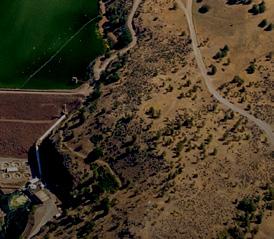


Vegetation, sediment, algae and phytoplankton pile up at the bottoms of reservoirs behind dams, where the organic






